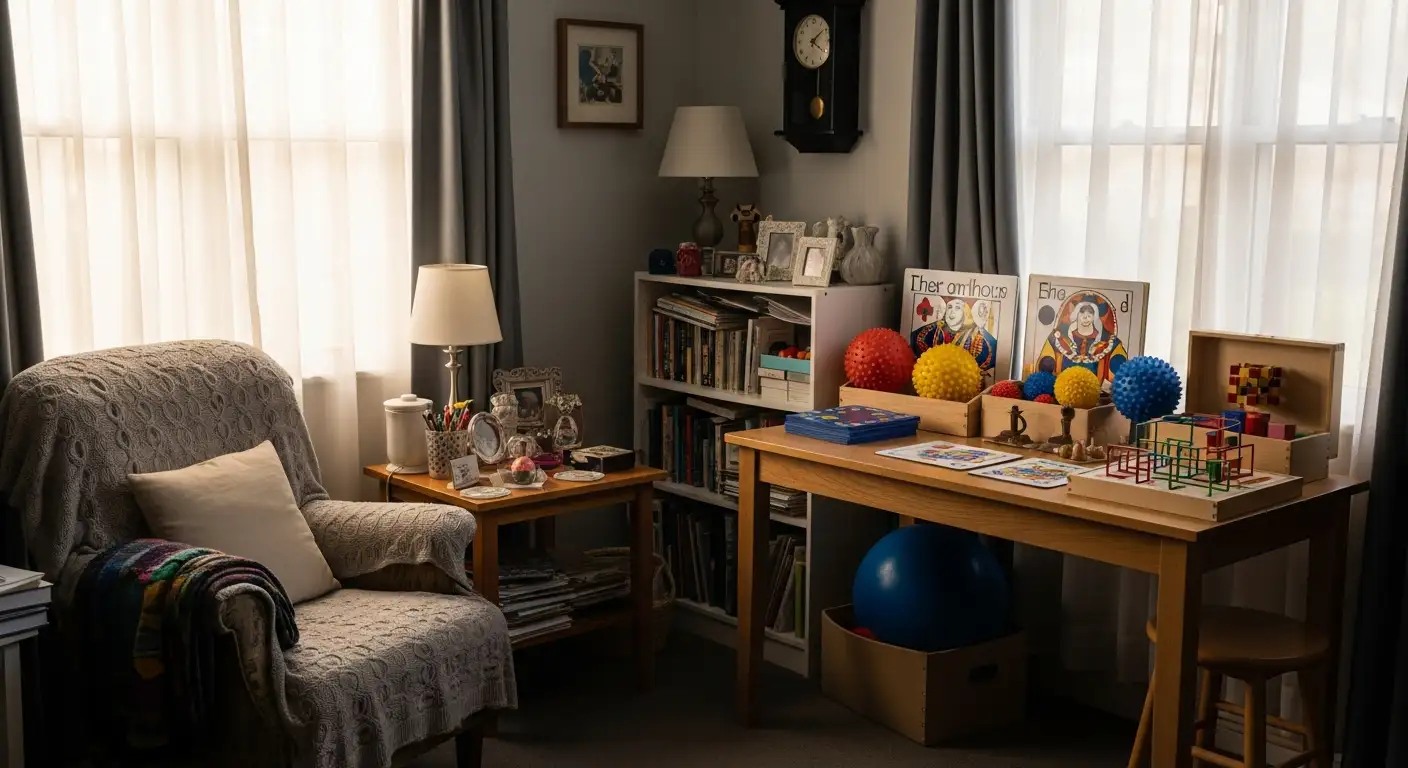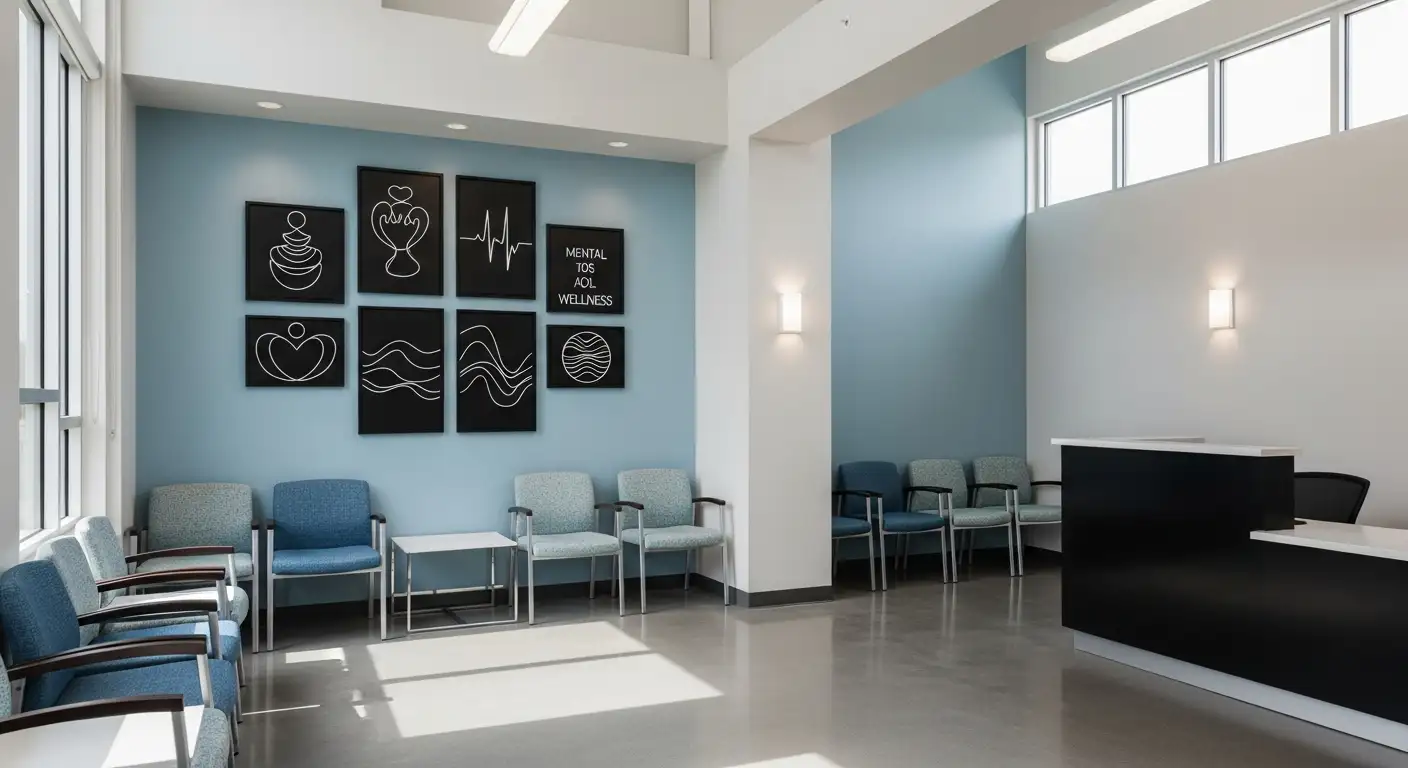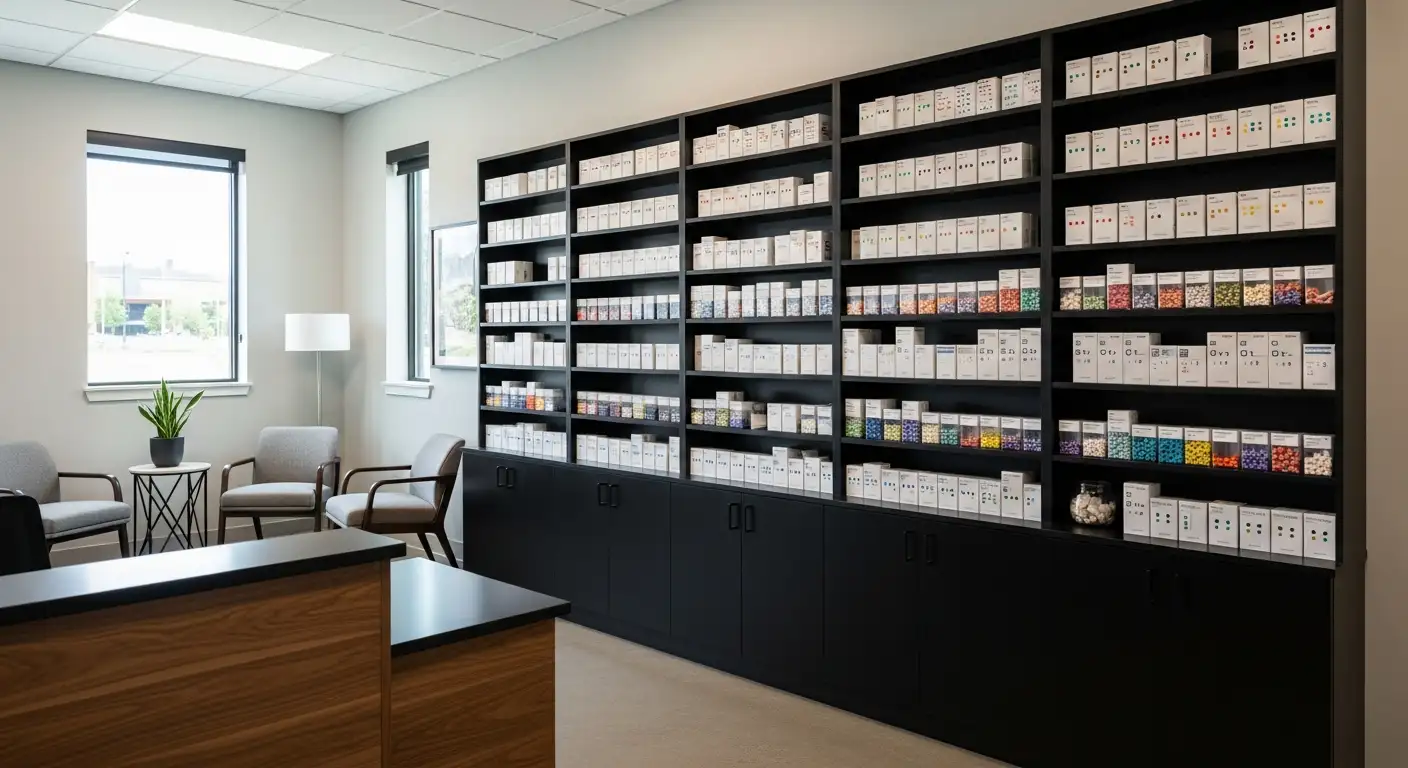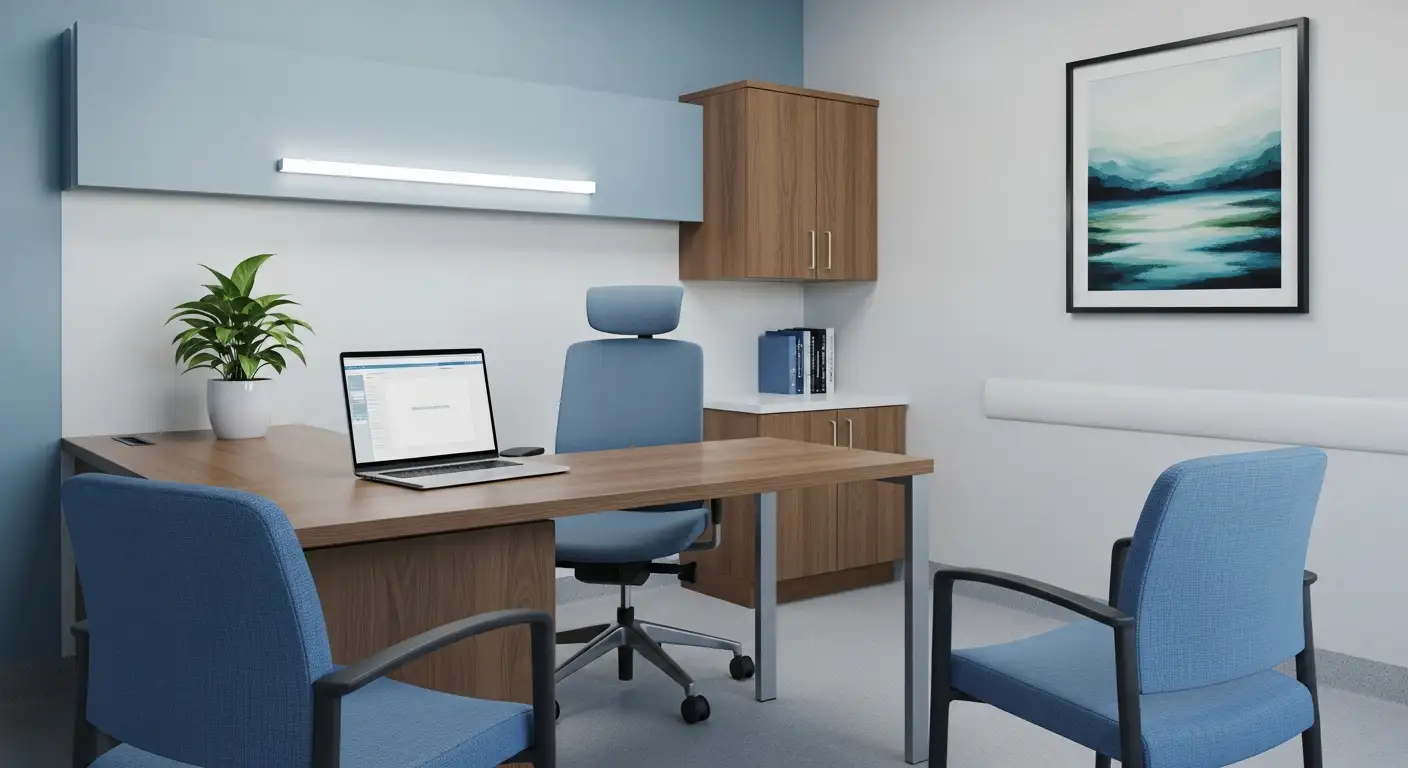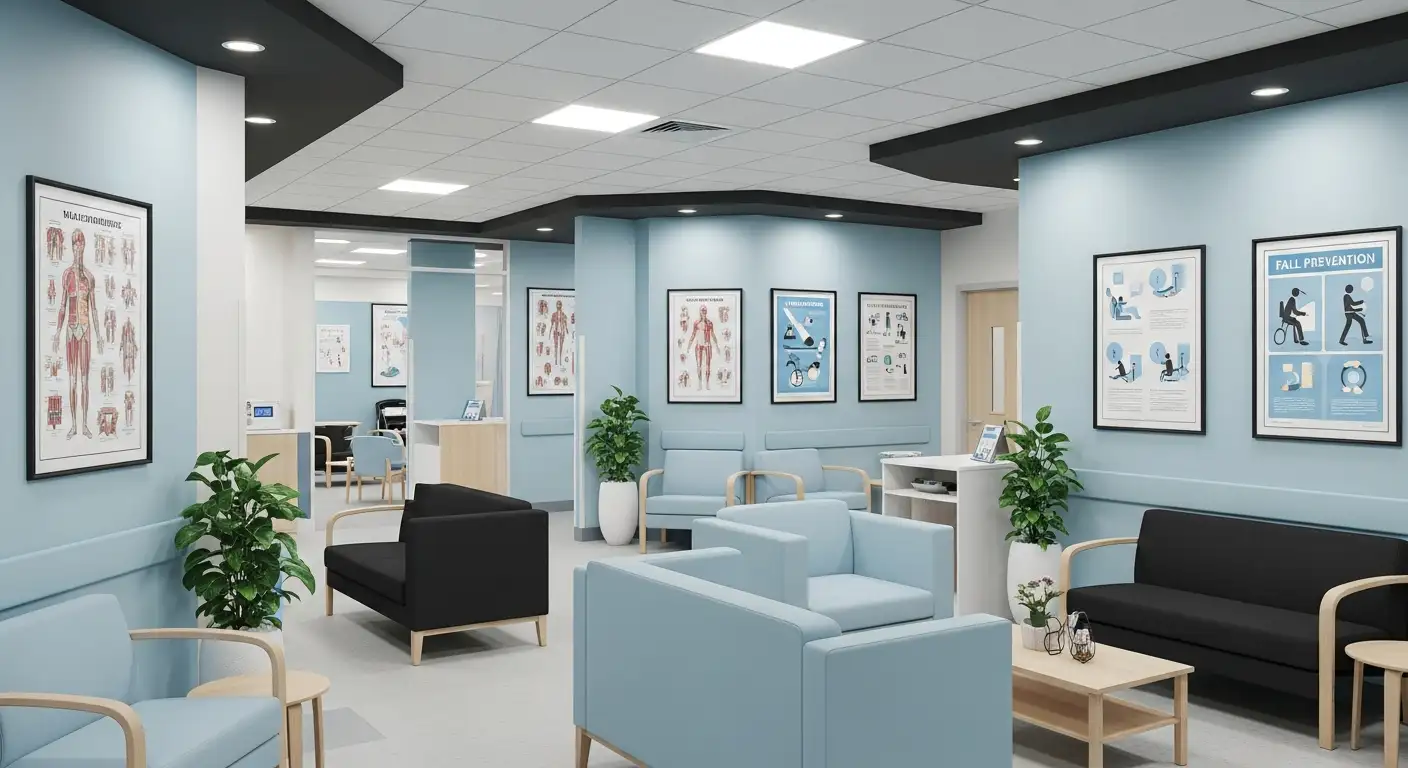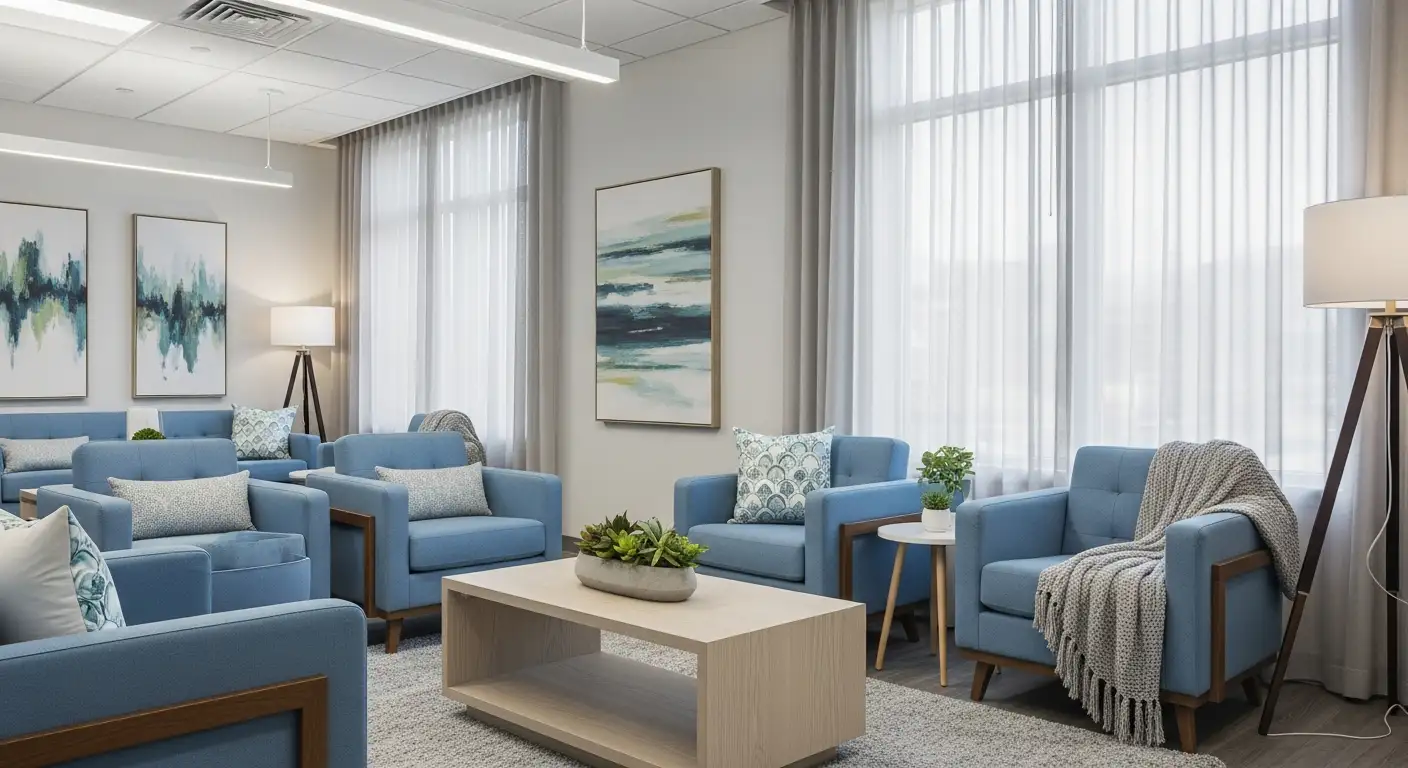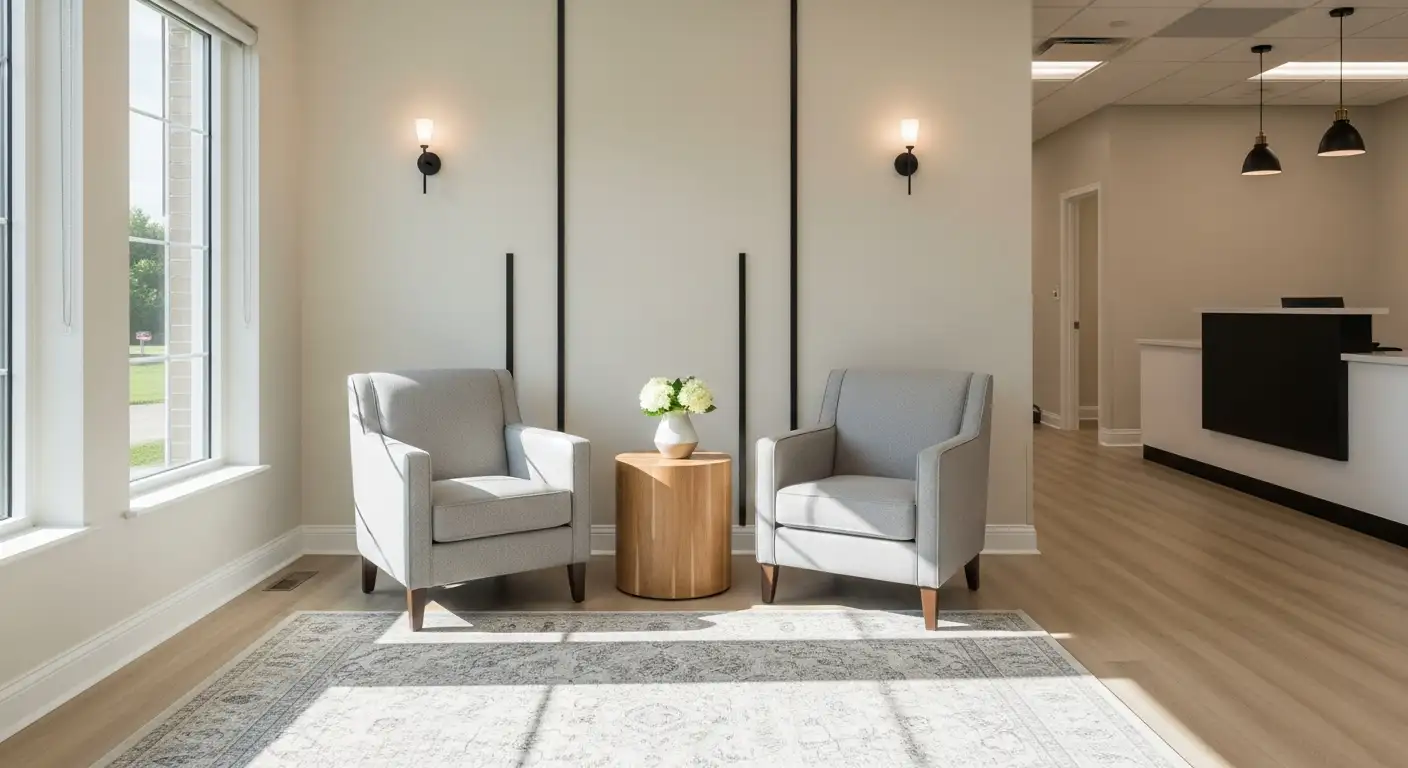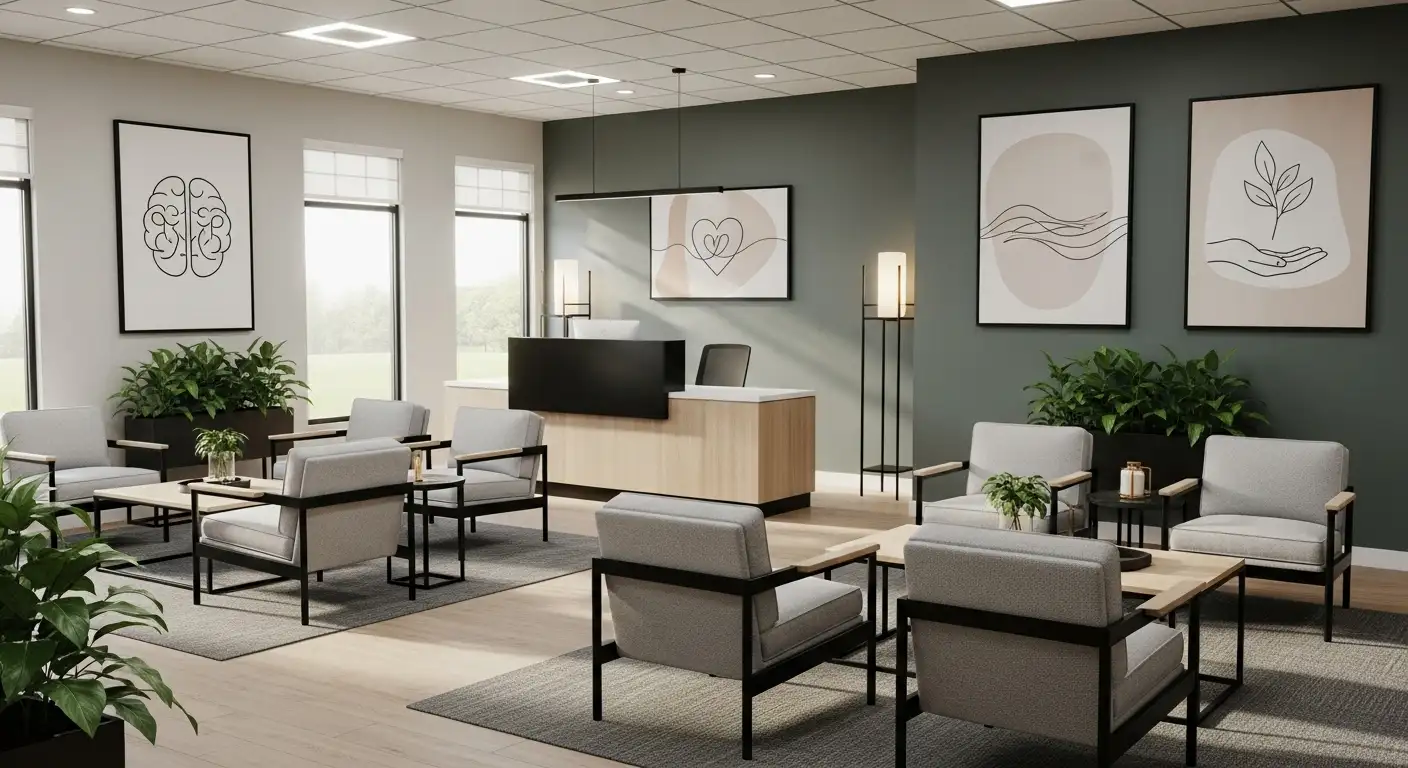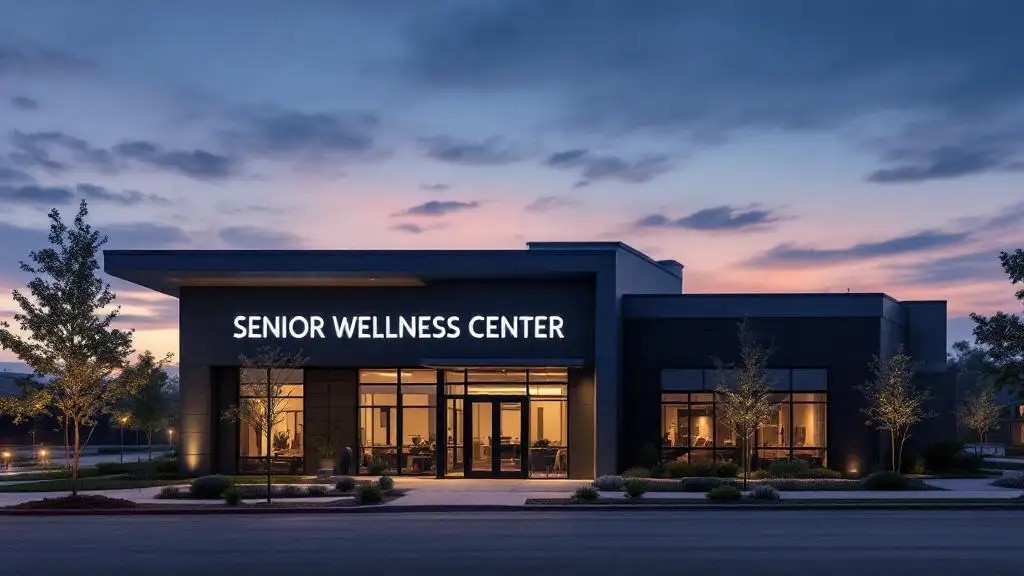The Critical Role of Mental Health Check-Ins for Seniors
As the population ages, the intersection of mental health and substance use challenges with physical health and cognitive impairments presents complex care needs for older adults, especially those in memory care. Regular mental health check-ins emerge as a vital practice to address these multifaceted issues, promoting better health outcomes, treatment adherence, and overall quality of life for seniors.
Understanding Comprehensive Treatment Services for Substance Abuse and Mental Health in Seniors
What Are Comprehensive Treatment Services for Substance Abuse and Mental Health Issues?
Comprehensive treatment services address substance abuse and mental health conditions in an integrated manner, recognizing that these issues often coexist and influence each other. For older adults, these services are crucial as they consider not only the substance use or psychiatric symptoms but also physical health conditions, cognitive impairments, and functional challenges common in this population.
How Is Substance Abuse and Mental Health Care Integrated?
Integration means delivering medical, mental health, and substance use treatment collaboratively within a coordinated system. For seniors, this includes combining medical detoxification, inpatient and outpatient programs, medication management, and psychosocial therapies. Integrated care models improve access and outcomes by reducing fragmentation, promoting medication adherence, and supporting community functioning.
What Treatment Modalities Are Available for Seniors?
- Medical Detoxification: Safe withdrawal management under clinical supervision.
- Inpatient and Residential Programs: Providing structured environments for intensive therapy.
- Partial Hospitalization and Intensive Outpatient Programs: Facilitating recovery while maintaining community living.
- Psychosocial Interventions: Examples include Cognitive Behavioral Social Skills and Assertive Community Treatment tailored for older adults.
- Medication-Assisted Treatment: Combining medication with counseling to treat co-occurring disorders.
- Support Services: Family involvement, caregiver support, and community resources extend recovery support.
What Is the Goal of Comprehensive Treatment?
The goal is to enhance long-term wellness by addressing the biological, psychological, and social aspects of both substance use and mental health conditions. It aims to improve treatment retention, reduce hospitalizations, enhance community and functional outcomes, and empower older adults through consistent, personalized engagement and regular mental health check-ins. This holistic approach supports seniors in achieving greater independence and quality of life.
Addressing Various Forms of Addiction in Older Adults: Tailored Treatment Approaches
How do treatment programs address various forms of addiction?
Treatment programs for addiction in older adults utilize a variety of evidence-based therapies tailored to the specific type of substance or behavioral addiction. Cognitive-behavioral therapy (CBT) is frequently used to help individuals develop coping mechanisms and manage triggers that may lead to substance use or relapse. Dialectical behavior therapy (DBT) also plays a role by focusing on emotional regulation and improving interpersonal effectiveness, which are crucial for sustaining recovery.
Experiential therapies like art therapy and animal-assisted therapy engage older adults on an emotional level, facilitating deeper subconscious processing and healing. When addiction is tied to past trauma, trauma-focused treatments such as Eye Movement Desensitization and Reprocessing (EMDR) are used to address those underlying issues.
Family involvement is an integral component of effective treatment and is often enhanced through motivational interviewing techniques. These strategies boost motivation, encourage honest communication, and strengthen the support system necessary for recovery.
Medications are also incorporated in many treatment plans, especially for alcohol or opioid dependence. Pharmacological options can reduce cravings, ease withdrawal symptoms, and support long-term abstinence. These medications are prescribed carefully with attention to older adults’ physical health conditions and interactions with other medications.
Combining these therapeutic approaches with regular counseling, peer support groups, and integrated care models helps promote sustained recovery, improve emotional resilience, and reduce relapse risk among older adults managing addiction.
Prevalence of Mental Health and Substance Use Conditions Among Seniors
How common are mental health and substance use conditions in older adults?
Mental health and substance use (MH/SU) conditions are quite prevalent among seniors. Estimates from 2010 indicate that about 14 to 20 percent of adults aged 65 and older experience one or more MH/SU disorders. This translates to roughly 5.6 to 8 million older adults affected by these conditions.
What other health challenges often accompany these conditions?
Older adults with MH/SU conditions frequently have multiple coexisting health issues that complicate detection and treatment. These include physical health problems, cognitive impairments such as memory loss, functional limitations, and sensory deficits like hearing or vision loss. Additionally, psychiatric symptoms—especially in those with dementia—are common and can feature depression, agitation, delusions, or apathy, affecting more than half of individuals with dementia.
How is the prevalence of MH/SU conditions expected to change?
The proportion and number of older adults with MH/SU conditions are expected to grow significantly by 2020 and 2030. This rise is driven by overall population growth, the aging of the baby boomer generation, and increasing rates of specific disorders, including alcohol and drug dependence. As the older population becomes larger and more diverse, addressing these conditions will require targeted strategies and workforce training.
Complexity of Diagnosing and Treating Mental Health and Substance Use in Seniors
What challenges arise due to coexisting conditions in older adults with MH/SU disorders?
Older adults with mental health and substance use (MH/SU) conditions often face a challenging clinical picture because these issues frequently coexist with physical health problems. This overlap complicates detection, diagnosis, and treatment, as symptoms may be intertwined or masked. For example, co-occurring chronic illnesses can mimic or exacerbate mental health symptoms, making it difficult for clinicians to isolate causes or properly tailor interventions.
How do sensory and cognitive impairments affect diagnosis and care?
Cognitive decline, functional impairments, and sensory losses common in older adults further complicate MH/SU diagnosis and management. Cognitive impairments, such as those seen in dementia, may confuse symptom presentation, with behavioral and psychiatric symptoms like depression, agitation, and delusions overlapping and blurring diagnostic clarity. Sensory impairments can also diminish an older adult’s ability to communicate symptoms effectively, resulting in underrecognition.
Why are mental health and substance use conditions underdiagnosed in medical care settings?
Despite frequent contact with healthcare providers in primary care and hospital settings, MH/SU conditions in older adults remain underdetected and undertreated. General medical providers may lack specialized training to identify these disorders, especially as symptoms can be masked by coexisting conditions or mistaken for normal aging. This underdiagnosis delays treatment and worsens outcomes.
The combination of physical illnesses, cognitive and sensory challenges, as well as gaps in provider expertise, positions the detection and management of MH/SU disorders in seniors as a complex clinical task that requires improved training, integrated care models, and regular mental health check-ins to tailor effective treatment strategies.
The Impact of Behavioral and Psychiatric Symptoms Associated with Dementia
What are common psychiatric symptoms in dementia?
Behavioral and psychiatric symptoms are widespread among older adults with dementia, affecting up to 57.2 percent of this population. These symptoms commonly include depression, agitation, delusions, and apathy. Such manifestations complicate the overall clinical picture, often overlapping with physical and cognitive impairments.
How do these symptoms affect treatment and care?
The presence of these psychiatric symptoms adds complexity to the diagnosis and treatment process. These symptoms may be underdetected or misattributed to other conditions, especially since older adults with dementia often receive care in general medical settings like primary care or hospitals. The challenges in pinpointing the exact causes make tailored treatment difficult, complicating interventions designed to improve quality of life and reduce institutionalization.
Why is mental health monitoring important?
Regular mental health monitoring through consistent check-ins is critical in managing these behavioral symptoms. Evidence suggests that ongoing assessment can reduce relapse rates by up to 40% in serious mental illnesses and improve treatment adherence by 30%. For dementia patients, frequent mental health evaluations allow healthcare providers to adjust treatment plans responsively, support caregivers, and address evolving care needs. Such holistic approaches foster therapeutic alliances and enhance patient engagement, ultimately leading to improved care outcomes.
Importance of Regular Mental Health Check-Ins in Memory Care
What Role Do Regular Check-Ins Play in Personalized Treatment for Older Adults?
Regular mental health check-ins are crucial for tailoring treatment to the unique and changing needs of older adults, especially those with memory impairments and dementia. Because behavioral and psychiatric symptoms such as depression, agitation, and delusions are common—affecting up to 57.2% of seniors with dementia—consistent evaluations allow clinicians to monitor symptom fluctuations and respond promptly. This personalized approach helps improve medication adherence and reduces the risk of relapse, with studies indicating that regular check-ins can decrease relapse rates by 25% in mood disorders and up to 40% in schizophrenia cases.
How Do Providers Adjust Treatment Plans Based on Evolving Needs?
Older adults with mental health or substance use conditions often present coexisting physical and cognitive challenges that evolve over time. Routine mental health assessments in memory care settings enable providers to adapt treatment plans flexibly. These adjustments may include modifying medication regimens, introducing or enhancing psychosocial interventions, or addressing newly emerging symptoms. The ongoing engagement fosters patient involvement and empowerment, contributing to a 30% increase in treatment adherence.
What Are the Holistic Benefits of Regular Mental Health Check-Ins?
Holistic care that integrates regular mental health check-ins promotes improved emotional resilience and sustained symptom management, particularly in anxiety and mood disorders. These check-ins strengthen the therapeutic alliance between providers and patients, facilitating better communication, trust, and overall satisfaction with care. Moreover, the comprehensive approach supports not only clinical treatment but also the quality of life, functional capabilities, and social needs of older adults, making it a vital component in effective memory care models.
How Regular Check-Ins Improve Treatment Adherence and Outcomes
Statistical Improvements in Adherence
Regular mental health check-ins have a significant impact on treatment adherence among older adults with MH/SU conditions. Studies demonstrate that involving patients consistently in their treatment plans through scheduled check-ins can increase adherence by 30%. This higher engagement enables better medication management and follow-through with prescribed therapies, essential factors for managing chronic mental health issues effectively.
Relapse Reduction Statistics
Consistent follow-up sessions play a crucial role in reducing relapse rates. For individuals with mood disorders, routine check-ins are linked to a 25% decrease in relapse occurrences. Even more notably, integrated regular check-ins for individuals with schizophrenia have achieved relapse reductions of up to 40%. These findings highlight the preventive power of sustained patient-provider communication in complex psychiatric conditions.
Patient Involvement and Engagement Benefits
Regular check-ins foster a therapeutic alliance that gives patients a stronger sense of control and satisfaction with their care. Patient engagement through these consistent interactions builds emotional resilience and encourages sustained improvement, especially in anxiety disorders. This personalized care approach leads to better long-term outcomes by enabling timely adjustments in treatment and promoting a collaborative care experience.
Overall, the data underscores that regular mental health check-ins not only increase treatment adherence but also substantially reduce relapse and enhance patient engagement, ultimately leading to improved outcomes for older adults managing MH/SU conditions.
The Therapeutic Alliance: Building Trust Through Consistent Engagement
Why Are Therapeutic Relationships Important in Geriatric Mental Health?
Developing a strong therapeutic alliance is crucial in mental health care for older adults. This relationship fosters trust, making patients feel more comfortable sharing sensitive issues, which is essential given the complexities introduced by coexisting physical, cognitive, and sensory impairments in this population. Consistent engagement between providers and seniors helps tailor care to evolving needs, ensuring treatments remain relevant and effective.
How Does the Therapeutic Alliance Impact Treatment Adherence and Satisfaction?
A robust therapeutic alliance significantly improves treatment adherence, with evidence suggesting a 30% increase when patients are actively involved in their care plans. Regular check-ins create a supportive environment that enhances patients' sense of agency and satisfaction with their care. This partnership also boosts long-term success, reducing relapse rates by up to 40% in conditions like schizophrenia and fostering better medication adherence by 20%. The alliance encourages sustained emotional resilience and better management of anxiety and mood disorders.
What Are Effective Strategies to Engage Seniors in Their Care?
Engaging older adults in their mental health treatment requires tailored communication and culturally competent approaches, especially given increasing diversity. Frequent counseling and medication monitoring provide structured opportunities for seniors to participate actively, promoting ownership of their recovery journey. Technologies like telehealth, when adapted for seniors' digital literacy, can further support consistent engagement. Additionally, involving family caregivers enhances advocacy and emotional support, strengthening the therapeutic alliance and treatment outcomes.
Integrating Medical and Behavioral Health Care for Seniors with Serious Mental Illness
What are the advantages of integrated care models?
Integrated care models combine medical and behavioral health services to provide a comprehensive support system for older adults with serious mental illness (SMI). These models facilitate coordination between healthcare providers, improving communication and ensuring that both physical and mental health needs are addressed simultaneously. This approach helps streamline care, reducing fragmentation and improving health outcomes by tackling the complex interplay between cognitive, functional, and sensory impairments often seen in this population.
How does self-management training benefit older adults with SMI?
Self-management training is a vital part of integrated care that empowers seniors with SMI to take an active role in managing their health conditions. Techniques such as Assertive Community Treatment, Cognitive Behavioral Social Skills Training, and Functional Adaptation Skills Training equip individuals with practical skills to handle symptoms, improve daily functioning, and maintain independence. These interventions also boost medication adherence and encourage healthier lifestyle choices, which are essential for long-term recovery.
Can integrated care models reduce hospitalization rates?
Yes, integrated care models have been shown to significantly reduce hospitalization and emergency service use among older adults with SMI. By providing proactive, continuous care and regular mental health check-ins, these models catch complications early and adjust treatment plans as needed. Studies indicate that such integrated approaches can lower relapse rates and emergency interventions, resulting in better community functioning and less frequent institutionalization.
Together, integrated care and self-management training offer an evidence-based framework that supports older adults with serious mental illness in achieving improved quality of life and health stability.
Psychosocial Interventions for Improving Functioning in Older Adults with Serious Mental Illness
What Are Effective Psychosocial Interventions for Older Adults with Serious Mental Illness?
Older adults diagnosed with serious mental illness (SMI) often face compounded challenges due to physical health conditions and functional impairments. Psychosocial interventions have shown promising results in improving symptom management, enhancing functioning, and promoting independent living among this population. Several evidence-based practices cater specifically to older adults' unique needs.
Assertive Community Treatment (ACT)
ACT is a team-based approach that provides comprehensive, community-based psychiatric treatment, rehabilitation, and support. For older adults, this means receiving tailored assistance aimed at maintaining stability and avoiding unnecessary hospitalizations. ACT teams typically include professionals from different disciplines working collaboratively to address both mental health and physical health needs.
Cognitive Behavioral Social Skills Training (CBSST)
CBSST blends cognitive behavioral therapy techniques with social skills training. This approach helps older adults improve communication, problem-solving, and social interactions, which can be impaired by serious mental illness. CBSST also addresses negative thought patterns to support better mood regulation and reduce symptoms like anxiety and depression.
Functional Adaptation Skills Training (FAST)
FAST focuses on enhancing the individual's ability to perform daily living activities through skill-building exercises. For seniors, this training can increase independence by boosting cognitive function and adaptive behavior skills, which are critical for managing both mental illness and age-related cognitive decline.
Integrated Illness Management and Recovery (IIMR)
IIMR offers a holistic approach that combines education about symptom management, medication adherence, and wellness strategies. This intervention empowers older adults to actively engage in their recovery and maintain long-term wellness, reducing hospital visits and improving quality of life.
Benefits of Psychosocial Interventions
Research indicates these interventions lead to increased treatment initiation and retention, improved medication adherence, enhanced community functioning, and reduced hospitalization and emergency service use. Their effectiveness lies in addressing the complex care needs of older adults with SMI through holistic, personalized support.
By adopting these psychosocial interventions, healthcare providers can better meet the mental health challenges of older adults, supporting improved outcomes and fostering greater independence.
Workforce Competencies: Training for Senior Mental Health and Memory Care
Specialized Training Needs for Geriatric Mental Health
Older adults with mental health and substance use (MH/SU) conditions present complex challenges due to frequent coexisting physical health problems, cognitive impairments, and sensory deficits. This complexity demands specialized training for healthcare providers in geriatric mental health. Training focuses on understanding the intersection of MH/SU with issues like dementia-related behavioral symptoms including depression and agitation. Providers must be adept at performing consistent mental health check-ins and creating adaptable treatment plans that accommodate evolving patient needs. Psychosocial interventions such as Assertive Community Treatment and Integrated Illness Management are important components of a well-rounded skill set that supports improved functioning and independent living.
Cultural Competence in a Diverse Aging Population
The growing diversity among older adults necessitates workforce competence in cultural sensitivity and competence. For example, higher rates of MH/SU conditions are suggested among Hispanic/Latino older adults, indicating that standard treatment approaches may require adaptation. Training programs emphasize culturally responsive practices to effectively address differences in symptom presentation, stigma, and access barriers. This cultural awareness enhances engagement and helps to foster strong therapeutic alliances essential for better treatment outcomes.
VA Workforce Specialization
Veterans aged 65 and older utilizing Veterans Affairs (VA) health services show a higher prevalence of MH/SU disorders such as PTSD and mood disorders compared to the general older adult population. This underscores the need for VA providers to receive specialized training tailored to veterans' unique experiences and comorbidities. Workforce preparation within VA settings prioritizes integrated care approaches and trauma-informed care practices to address these needs effectively.
Comprehensive geriatric mental health workforce training that includes these elements is vital for improving detection, treatment adherence, and clinical outcomes in older adults with complex MH/SU issues. This preparation supports the larger goal of delivering high-quality, person-centered care that meets the evolving demands of an aging, diverse population.
Addressing Systemic Barriers to Mental Health Care Access for Older Adults
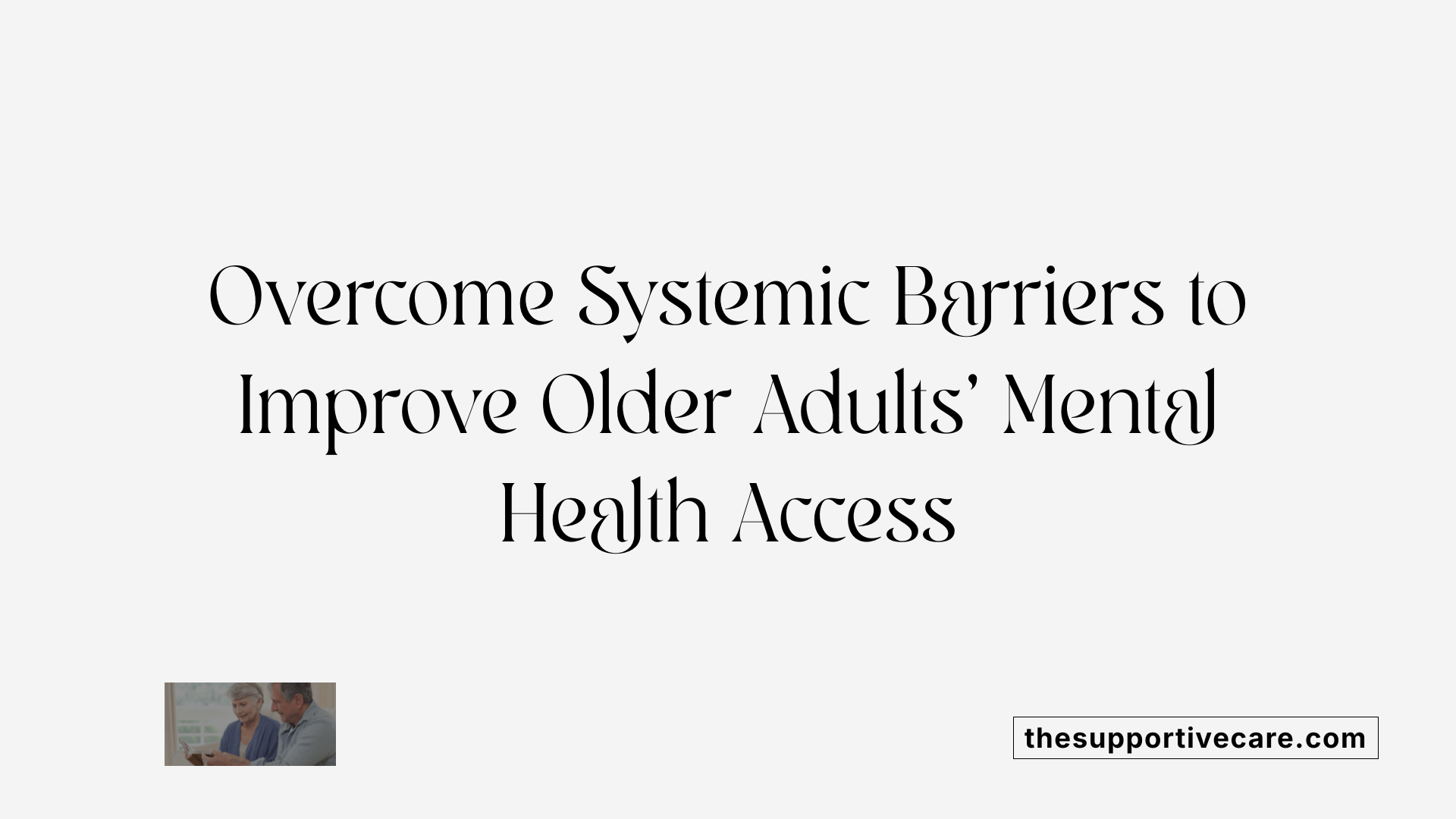
What Are the Systemic Barriers Affecting Mental Health Care Access for Older Adults?
Older adults with mental health and substance use (MH/SU) conditions frequently face significant systemic barriers that hinder access to quality care. Three major challenges include care fragmentation, insufficient provider training, and insurance coverage difficulties.
How Does Care Fragmentation Impact Older Adults?
Care fragmentation occurs when older adults receive MH/SU and physical health services separately, often from multiple providers who may not communicate effectively. This separation complicates treatment coordination, especially given the common coexisting physical, cognitive, and sensory impairments in this group. Fragmented care leads to underdetection and undertreatment of MH/SU conditions, reducing the overall quality of care.
Why Is Provider Training Insufficient?
Many general medical settings, including primary care and hospitals where older adults often seek help, lack providers trained specifically in geriatric mental health. This training gap limits the workforce's ability to identify and effectively treat MH/SU disorders complicated by aging-related factors. Specialized training in integrated care models and culturally competent approaches is essential to improve diagnosis, treatment, and support.
What Are the Challenges With Insurance Coverage?
Insurance-related obstacles present another significant barrier. Limited coverage for mental health services, especially those involving integrated and psychosocial interventions, restricts older adults' access to comprehensive care. Inadequate insurance plans also impede continuity of treatment, medication adherence, and frequent mental health check-ins that are critical for improving outcomes.
Why Is Addressing These Barriers Crucial?
Addressing these systemic issues is vital to enhance care coordination, increase treatment initiation and retention, and reduce hospitalization rates among older adults. Integrated service delivery efforts supported by appropriate training and insurance reforms can lead to better health outcomes, improved quality of life, and greater independence for this vulnerable population.
Cultural Competency in Mental Health Care for a Diverse Aging Population

How Do Prevalence Rates of Mental Health and Substance Use Conditions Vary Across Racial and Ethnic Groups?
Prevalence of mental health and substance use (MH/SU) conditions differs among racial and ethnic groups within the older adult population. Notably, Hispanic/Latino seniors tend to exhibit higher rates of certain MH/SU conditions compared to other groups. As the older adult demographic becomes increasingly diverse, the variation in MH/SU prevalence underscores the need for culturally informed care approaches.
Why Is Culturally Adapted Care Important for Older Adults?
Culturally adapted care is vital to effectively address the unique needs of diverse older populations. Tailoring interventions to respect cultural beliefs, values, and communication styles enhances engagement and treatment adherence. This personalized care approach helps reduce underdetection and undertreatment, common challenges in general medical settings where many older adults receive MH/SU services.
What Training Frameworks Support Cultural Competency in Geriatric Mental Health?
Workforce training emphasizing cultural competence is essential for meeting the needs of a diverse aging population. Effective frameworks incorporate the following elements:
- Cultural awareness and sensitivity: Educating providers about cultural differences impacting MH/SU conditions and treatment preferences.
- Use of culturally adapted evidence-based practices: Modifying interventions to fit cultural contexts.
- Communication skills training: Enhancing provider ability to build trust and rapport.
- Ongoing fidelity monitoring and adjustment: Ensuring interventions remain culturally relevant over time.
Frameworks such as the 4Ms (What Matters, Medication, Mentation, Mobility) can guide holistic care that integrates cultural considerations. Moreover, the RE-AIM framework supports sustained implementation and scalability of culturally competent programs.
By training a workforce skilled in cultural competence and integrating these approaches within care models, the mental health system can better serve the diverse and growing older adult population, improving access, engagement, and outcomes.
The Growing Mental Health Needs of Older Adults in Congregate Living Settings
What Mental Health Challenges Do Older Adults Face in Congregate Living?
Older adults living in congregate settings—such as nursing homes, assisted living facilities, and public housing—often experience significant mental health and substance use (MH/SU) challenges. These environments bring together large numbers of older individuals who frequently have coexisting physical health conditions, cognitive impairments, and sensory disabilities, which can complicate the detection and treatment of MH/SU conditions.
Why Are These Settings Particularly Challenging?
Congregate living situations pose unique obstacles for MH/SU care. Residents may undergo social isolation or face stigma, and the diverse needs of residents demand tailored approaches to care. Furthermore, workforce competencies in these settings are still developing, highlighting a critical need for specialized training to identify and treat MH/SU disorders effectively.
How Do Nursing Homes and Assisted Living Differ in MH/SU Needs?
- Nursing Homes: Typically serve individuals with more advanced physical and cognitive impairments, which heightens behavioral and psychiatric symptoms like depression, agitation, and apathy.
- Assisted Living: While offering more independence, residents here may still grapple with MH/SU conditions that require supportive interventions and vigilant monitoring.
What About Public Housing?
Older adults living in public housing confront additional challenges such as limited access to healthcare resources and potential socioeconomic stressors. These factors contribute to higher rates of MH/SU conditions and call for culturally competent and accessible mental health services.
Workforce Training and Intervention Priorities
To address these multifaceted issues, workforce development focusing on geriatric mental health care is a high priority. Evidence-based psychosocial interventions, integrated care models, and routine mental health screening adapted for congregate living environments can improve detection and treatment outcomes.
Improving mental health among older adults in congregate living settings requires holistic approaches that combine medical, behavioral, and social supports tailored to the complexities of these environments.
Veterans and Mental Health: Specialized Needs in Older Populations
PTSD Prevalence Among Older Veterans
Veterans aged 65 and older using VA health care services exhibit higher rates of post-traumatic stress disorder (PTSD) than their non-veteran peers. This elevated prevalence reflects the unique traumas experienced during military service, which can have long-lasting effects well into later life. PTSD in this population often intersects with other mental health challenges, necessitating specialized attention.
Mood and Substance Use Disorders in Older Veterans
In addition to PTSD, older veterans commonly face mood disorders such as depression and anxiety, as well as substance use disorders including alcohol and drug dependence. These conditions frequently coexist, further complicating diagnosis and management. The increased prevalence underscores the need for comprehensive screening and tailored interventions within veteran healthcare settings.
VA Specialized Programs for Mental Health
The Department of Veterans Affairs (VA) has developed specialized programs targeting the complex mental health needs of older veterans. These initiatives focus on integrated care models that combine behavioral health with primary care, ensuring holistic treatment. Workforce training within VA facilities emphasizes geriatric mental health competencies alongside cultural sensitivity to effectively address these unique challenges.
Through these targeted efforts, VA healthcare services aim to improve treatment adherence, reduce hospitalizations, and enhance overall quality of life for aging veterans facing mental health and substance use disorders.
Family Caregivers’ Role in Supporting Mental Health Treatment and Recovery
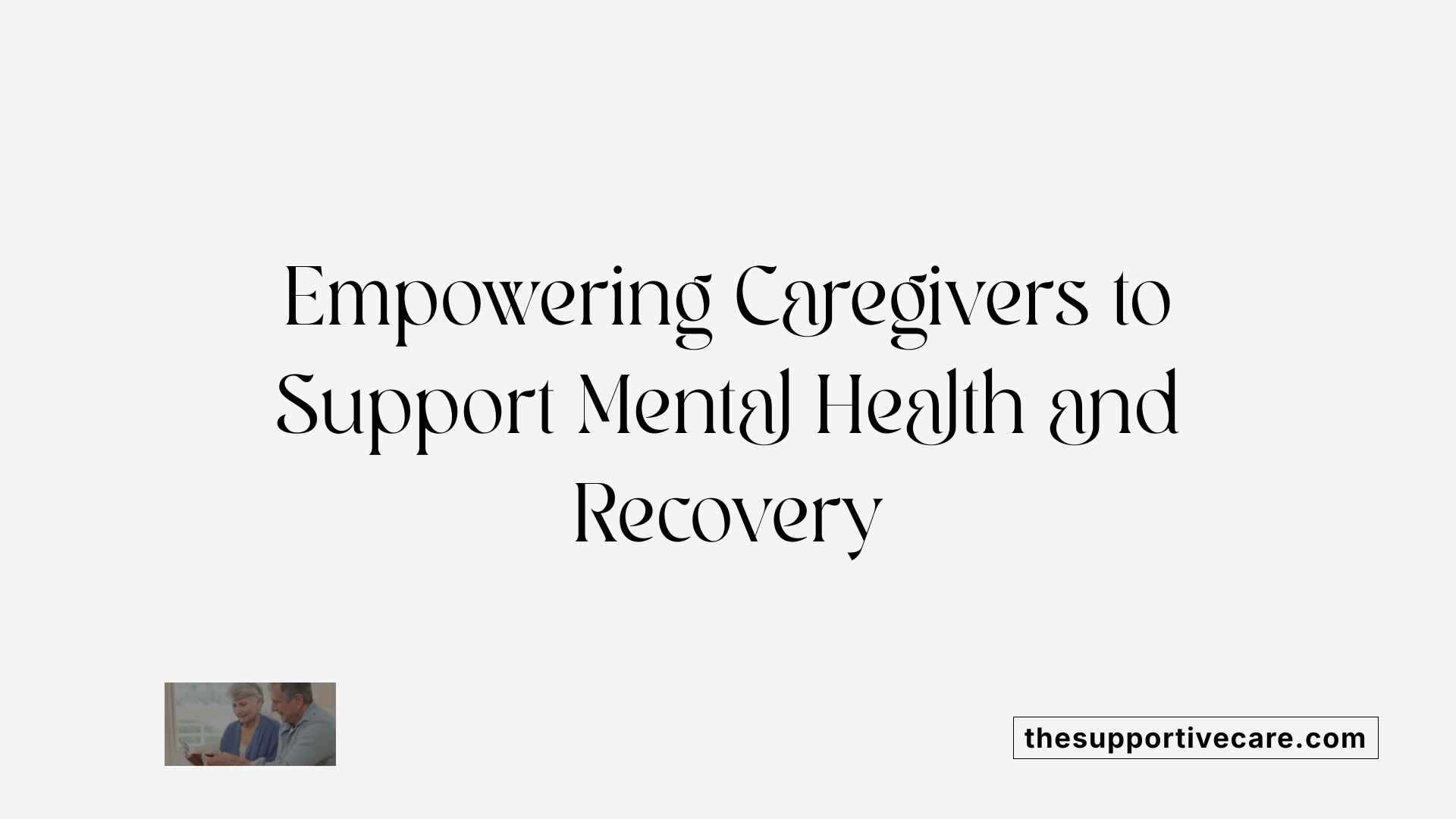
How Do Family Caregivers Provide Emotional Support?
Family caregivers offer crucial emotional support for older adults managing mental health and substance use conditions. They provide comfort, understanding, and reassurance during treatment and recovery, often helping to reduce feelings of isolation and anxiety. This emotional presence fosters a positive environment that encourages healing.
In What Ways Do Caregivers Advocate for Treatment Adherence?
Caregivers play an active role in promoting treatment adherence by helping older adults attend appointments, reminding them to take medications, and explaining treatment plans. Their involvement increases treatment adherence by about 30%, as regular check-ins and involvement instill a sense of accountability and motivation in patients.
Why Are Family Caregivers Important in Recovery?
Beyond emotional and practical support, caregivers serve as advocates within healthcare systems, ensuring that older adults receive appropriate care and resources. Their involvement correlates strongly with improved recovery outcomes, such as enhanced community functioning and reduced hospitalizations. Involving caregivers builds a therapeutic alliance, which is essential for sustained mental health improvements.
Together, emotional support, treatment adherence advocacy, and active involvement in recovery make family caregivers indispensable partners in caring for older adults with mental health and substance use challenges.
Telehealth and Mobile Technologies: Expanding Access for Senior Mental Health Care
What are the potential benefits of telehealth and mobile health technologies for older adults?
Telehealth and mobile health technologies offer promising ways to expand access to mental health services for older adults. They can overcome geographical barriers, provide flexible scheduling, and allow seniors with mobility issues to receive care in the comfort of their homes. These technologies support ongoing treatment engagement through regular virtual check-ins, which are linked to improved treatment adherence and reduced relapse rates. By facilitating continuous communication, telehealth also helps foster a strong therapeutic alliance between patients and providers, enhancing overall treatment outcomes.
What barriers exist for older adults in using telehealth and mobile technologies?
Despite the benefits, several barriers limit the effectiveness of telehealth for older populations. Digital literacy is a significant concern; many seniors may lack experience or confidence with smartphones, tablets, or computers. Access to reliable internet service can also be inconsistent, especially in rural or low-income areas. Cognitive or sensory impairments common in older adults further complicate technology use. Additionally, there can be privacy and security concerns, which may deter some seniors from fully engaging with digital health platforms.
How can telehealth approaches be tailored for seniors to improve usability and outcomes?
To maximize telehealth's potential, approaches must be tailored to the unique needs of older adults. User-friendly interfaces with simplified navigation and larger visual elements can aid those with sensory impairments. Providing technology training and ongoing technical support helps build confidence and digital skills. Incorporating caregivers in telehealth visits can improve communication and adherence. Cultural competence and personalization of care plans, including language preferences, ensure relevant and effective service delivery. Finally, integrating telehealth with traditional care models and regular in-person interactions supports a comprehensive holistic approach.
By addressing these barriers and customizing telehealth solutions, healthcare providers can significantly enhance mental health care access and quality for the growing older adult population, aligning with evidence-based practices for improved outcomes.
Implementing Evidence-Based Practices in Senior Mental Health Settings
How are planning and staff training conducted for evidence-based practices?
Successful implementation of mental health interventions for older adults begins with careful planning and comprehensive staff training. Planning includes assessing the specific needs of the senior population, addressing systemic barriers like care fragmentation, and adopting culturally competent approaches to meet diverse populations. Staff training emphasizes skill development in geriatric mental health, understanding co-occurring conditions, and delivering integrated care services.
What role does fidelity monitoring play in the implementation process?
Fidelity monitoring ensures that evidence-based interventions are delivered as intended, preserving their effectiveness. Regular assessments of staff performance and adherence to treatment protocols allow organizations to identify gaps and provide ongoing support. This continuous quality assurance helps sustain the integrity of adapted programs and facilitates necessary adjustments to better respond to older adults’ evolving needs.
How do frameworks such as the 4Ms and RE-AIM support mental health programs for older adults?
Frameworks like the 4Ms (What Matters, Medication, Mentation, and Mobility) guide clinicians to deliver holistic care that prioritizes older adults’ goals and safety. RE-AIM (Reach, Effectiveness, Adoption, Implementation, Maintenance) offers a structured approach to evaluate program impact and sustainability across multiple dimensions. Together, these frameworks promote a systematic integration of evidence-based practices, ensuring that mental health services are person-centered, culturally sensitive, and enduring.
Integrated efforts involving detailed planning, dedicated staff training, fidelity monitoring, and the use of robust implementation frameworks are critical for improving mental health outcomes among older adults. Such strategies empower healthcare providers to support complex needs and enhance quality of care in geriatric mental health settings.
The Role of Ongoing Medication Monitoring in Treatment Success
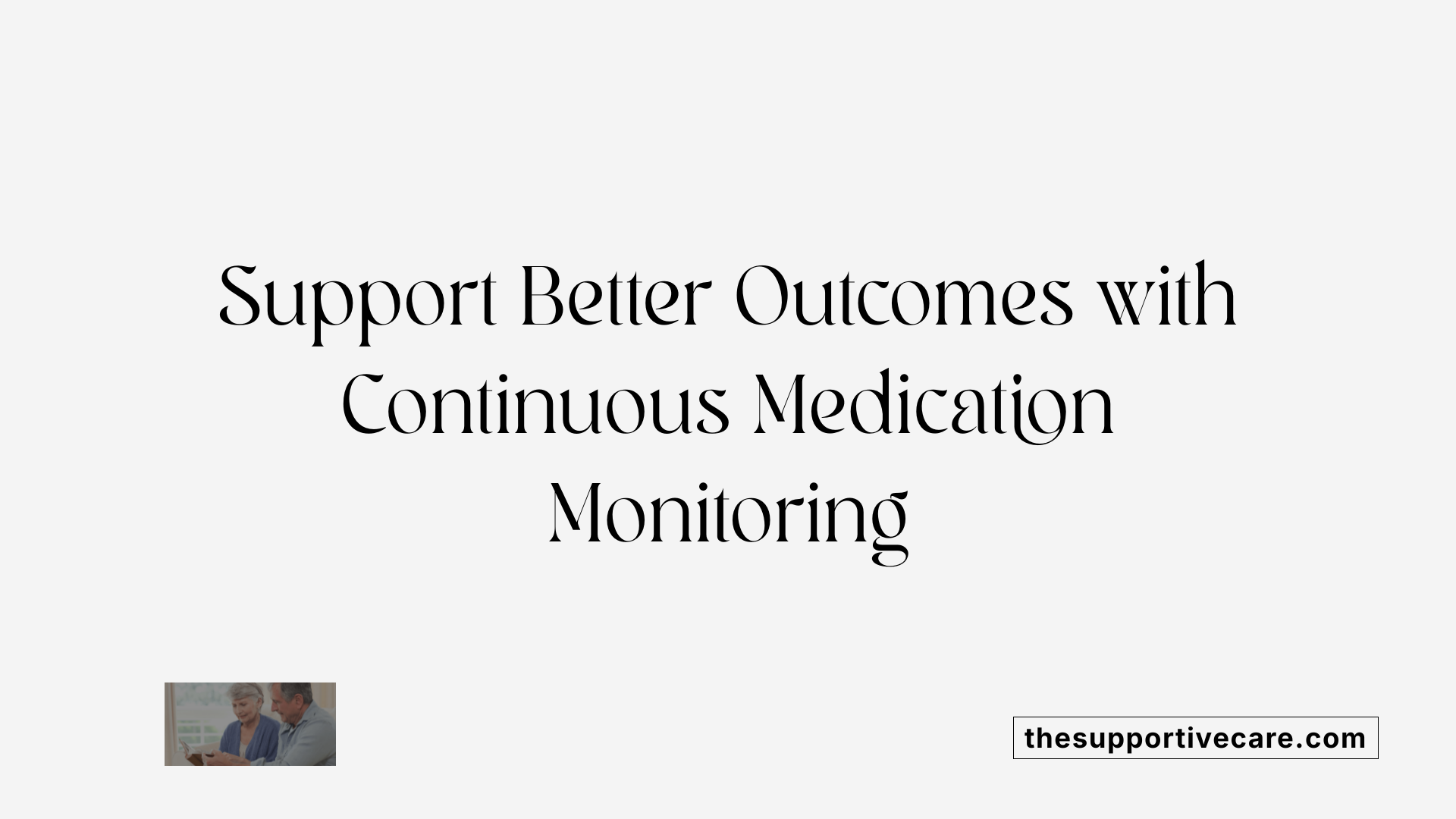
How does ongoing medication monitoring impact treatment outcomes in older adults?
Ongoing medication monitoring plays a vital role in improving treatment outcomes for older adults with mental health and substance use (MH/SU) conditions. Research shows that consistent medication monitoring can lead to a 20% improvement in treatment results by ensuring adherence and adjusting dosages as needed. This vigilance helps reduce adverse effects and supports medication effectiveness over time.
Why is medication monitoring important for relapse prevention?
Medication monitoring is crucial in preventing relapse among older adults, especially those with mood and severe mental disorders. Regular check-ins help detect early warning signs of relapse, allowing timely interventions. For instance, systematic follow-ups have been linked to a reduction of up to 40% in relapse rates, particularly in conditions like schizophrenia. These preventive practices contribute to sustained recovery and better community functioning.
What are recommended protocols for effective medication monitoring?
Effective medication monitoring involves scheduled assessments that include reviewing side effects, evaluating adherence patterns, and collaborating with patients and caregivers. Integrated care models recommend combining medical and behavioral health services with self-management training to support this process. Additionally, personalized adjustments during routine check-ins foster patient engagement, improving treatment adherence by about 30%. Protocols emphasize cultural competence and tailored communication to address the diverse needs of older adults.
Regular and structured medication monitoring serves as a cornerstone for achieving enhanced treatment adherence, reducing hospitalization rates, and maintaining emotional stability among older adults with MH/SU conditions. By integrating these practices within holistic care frameworks, healthcare providers can better respond to the complexities of aging populations.
Addressing Mood Disorders Through Regular Mental Health Check-Ins
How do regular mental health check-ins impact relapse rates?
Regular mental health check-ins play a crucial role in reducing relapse rates among older adults dealing with mood disorders. Studies indicate that consistent check-ins are associated with a 25% reduction in relapse rates. By regularly monitoring symptoms and treatment responses, healthcare providers can make timely adjustments that prevent the worsening of symptoms, ultimately supporting more stable mental health.
What is the role of check-ins in treatment retention?
Frequent mental health check-ins also contribute to a significant increase—up to 30%—in treatment adherence. These check-ins actively involve patients in their care plans, fostering a therapeutic alliance between patients and providers. This engagement enhances satisfaction with care and encourages patients to continue with their prescribed treatments, which is essential for sustained recovery.
How do regular check-ins improve emotional resilience?
Ongoing counseling sessions and mental health check-ins are linked to better long-term emotional resilience and sustained improvement in anxiety and mood disorders. By providing continual support and coping strategies, these check-ins help older adults build skills to manage stress and emotional challenges, improving their overall quality of life.
In summary, regular mental health check-ins for older adults with mood disorders offer measurable improvements in relapse prevention, treatment retention, and emotional resilience. These interventions are indispensable components of effective mental healthcare for the aging population.
Managing Anxiety Disorders in Seniors With Consistent Counseling Check-Ins
Long-Term Improvement and Emotional Resilience
Consistent counseling check-ins play a crucial role in managing anxiety disorders among older adults. Frequent therapy sessions have been linked to sustained improvement in anxiety symptoms over time. These regular check-ins provide ongoing support, allowing seniors to develop stronger emotional resilience. This resilience helps them better cope with stressors and maintain mental well-being despite age-related challenges.
Therapy Adherence and Patient Engagement
Regular counseling appointments contribute to a 30% increase in treatment adherence by actively involving seniors in their own care plans. This heightened engagement fosters a sense of agency and personal investment in recovery. Moreover, the therapeutic alliance formed through these consistent interactions strengthens trust and communication, which are vital for successful outcomes.
Impact on Treatment Outcomes
Research shows that ongoing counseling check-ins not only reduce relapse rates but also improve emotional stability in the long term. The supportive environment encourages seniors to adhere to medication routines and develop coping strategies, resulting in more effective anxiety management and improved quality of life.
Together, these benefits highlight the importance of integrating frequent counseling sessions into mental health care for older adults struggling with anxiety disorders. Such an approach promotes emotional resilience, enhances adherence to therapy, and supports lasting improvement in mental health.
Reducing Relapse in Schizophrenia Through Integrated Regular Check-Ins
How do regular check-ins impact relapse rates in schizophrenia?
Integrated regular check-ins have been shown to reduce relapse rates in individuals with schizophrenia by up to 40%. These consistent interactions enable healthcare providers to closely monitor symptoms, adjust treatments promptly, and address emerging issues before they escalate.
What is the effect of regular check-ins on treatment adherence?
Regular check-ins increase treatment adherence by approximately 30%. When patients are involved in ongoing conversations about their care, they develop a stronger commitment to following medication regimens and therapeutic plans. This adherence is critical for managing symptoms effectively and preventing relapse.
How do patient engagement and therapeutic alliance relate to mental health treatment outcomes?
Consistent check-ins foster patient engagement by creating a sense of agency and empowerment. Patients feel more valued and heard, which increases satisfaction with their treatment. Additionally, the therapeutic alliance formed through these regular interactions enhances trust and communication between patients and providers, leading to improved overall treatment outcomes.
By integrating these check-ins into standard care, especially for older adults with schizophrenia and coexisting mental health and substance use conditions, healthcare systems can significantly improve stability and quality of life for this vulnerable population.
The Future Demand for Integrated Mental Health Care Among Older Adults
Why is service demand for mental health care among older adults rising?
The demand for mental health and substance use (MH/SU) services in older adults is projected to grow substantially by 2020 and 2030. This surge stems from population growth, the aging baby boomer cohort, and increased prevalence rates of conditions like alcohol and drug dependence. Additionally, older adults in congregate living settings and subpopulations such as veterans and ethnic minorities present unique and increasing MH/SU needs.
How does ongoing monitoring support treatment for older adults?
Regular mental health check-ins are crucial in managing the complex and evolving needs of older adults. Studies link these ongoing assessments to outcomes such as a 25% reduction in relapse rates among individuals with mood disorders, a 20% improvement in treatment outcomes through medication monitoring, and a 30% increase in treatment adherence by fostering patient engagement. Frequent counseling check-ins also promote emotional resilience and sustained improvements, particularly in anxiety and schizophrenia.
How does integrating services improve mental health outcomes?
Integrated care models that combine medical and behavioral health services—such as self-management training—are evidence-based approaches that enhance health outcomes in older adults with serious mental illness. These models address care fragmentation and leverage multidisciplinary collaboration, supported by frameworks like the 4Ms and RE-AIM. Integration helps overcome barriers including provider training gaps and insurance coverage, ensuring holistic management of MH/SU alongside physical and cognitive health issues.
By strengthening workforce competencies in geriatric mental health and embedding consistent, culturally competent monitoring protocols, the mental health system can better meet the complex and growing needs of the aging population.
Population Growth and Aging: Increasing Mental Health Service Needs
How Does the Aging Baby Boomer Cohort Affect Mental Health Service Demand?
The aging of the baby boomer generation significantly contributes to the growing need for mental health and substance use (MH/SU) services among older adults. As this large cohort moves into older age, the overall number of adults aged 65 and older with MH/SU conditions is expected to rise sharply. This demographic shift means that healthcare systems must anticipate not only a larger population but also higher complexity of care needs.
What Are the Trends in Condition Prevalence Rates?
Prevalence rates for MH/SU conditions are increasing, especially for substance dependence such as alcohol and drug use disorders among older adults. Estimates from 2010 suggest that 14 to 20 percent of individuals aged 65 and older, or approximately 5.6 to 8 million people, experience one or more MH/SU conditions. This figure is likely to grow due to both the expanding population size and rising rates of certain conditions.
How Should Health Services Plan for Increased Demand?
Effective planning to address this increased demand requires:
- Expanding workforce competencies, particularly in geriatric mental health and integrated care models.
- Developing culturally competent services to address greater population diversity.
- Increasing training in congregate and long-term care settings, where many older adults reside.
- Implementing evidence-based, integrated treatment approaches that combine medical and behavioral care.
By preparing now for the surge in older adults with MH/SU needs, healthcare systems can improve detection, diagnosis, and treatment outcomes, ensuring older adults receive comprehensive, coordinated care.
Addressing Substance Use Disorders Within Memory Care Settings
What Are the Recognition Challenges for Substance Use in Memory Care?
Older adults with memory impairments often face difficulties in recognizing substance use disorders (SUD) due to overlapping symptoms with cognitive decline and physical health conditions. This overlap complicates detection as behaviors linked to SUD, such as agitation or apathy, can easily be mistaken for dementia-related psychiatric symptoms. Additionally, sensory and functional impairments further hinder accurate diagnosis and timely intervention.
How Can Integrated Treatment Approaches Help?
Effective treatment for substance use disorders in memory care settings hinges on integrated care models. These models blend medical, behavioral, and psychosocial services to address the complex needs of older adults with coexisting physical and cognitive impairments. Programs like Assertive Community Treatment and Integrated Illness Management provide strategies for symptom management and promote independent living. Integrated care also emphasizes medication adherence and community functioning, which are essential for improving outcomes in this demographic.
Why Are Regular Mental Health Check-Ins Crucial?
Regular mental health check-ins are fundamental in memory care to monitor evolving needs and adjust treatment plans accordingly. These check-ins foster patient engagement, enhance the therapeutic alliance, and promote better adherence to treatment protocols. Studies indicate that such ongoing monitoring can reduce relapse rates by up to 40% in serious mental illnesses and improve medication adherence by 20%. In memory care, check-ins offer personalized oversight and help distinguish between cognitive symptoms and behavioral manifestations of substance use, leading to timely and tailored responses.
By prioritizing integrated approaches and consistent mental health evaluations, memory care settings can better support older adults with substance use disorders, ultimately enhancing their quality of life and healthcare outcomes.
Sensory and Functional Impairments Impact on Mental Health Treatment
How do sensory and functional impairments complicate treatment for older adults with mental health and substance use conditions?
Older adults with mental health and substance use (MH/SU) conditions often face additional challenges due to sensory, cognitive, and functional impairments. These impairments complicate detection, diagnosis, and treatment because symptoms may overlap or mask one another. For example, hearing loss or visual impairments can hinder effective communication during clinical assessments, while cognitive decline can obscure the presentation of psychiatric symptoms.
How is mental health care adapted to accommodate these impairments?
Adapting care for older adults with sensory and functional impairments involves a multidisciplinary approach emphasizing integrated medical and behavioral health services. Regular check-ins are especially crucial, allowing clinicians to tailor treatment plans as patients’ cognitive and functional abilities evolve. Utilizing evidence-based psychosocial interventions like Assertive Community Treatment and Functional Adaptation Skills Training helps improve daily functioning and symptom management despite these challenges.
What supportive interventions improve outcomes for this population?
Supportive interventions focus on enhancing communication and engagement. Family caregivers play a vital role by providing emotional support, helping with treatment adherence, and offering advocacy. Telehealth and mobile health technologies show promise but require modification for older adults who may face digital literacy barriers or limited access. Integrating these supportive services within a trained geriatric mental health workforce is essential to deliver culturally competent and accessible care.
| Challenge | Adaptation Strategy | Supportive Intervention |
|---|---|---|
| Sensory impairments (hearing, vision) | Use of assistive devices and clear communication | Family caregiver involvement for adherence |
| Cognitive and functional impairments | Tailored psychosocial training and regular check-ins | Integrated care models blending medical and behavioral services |
| Communication barriers | Simplified, repeated instructions and accessible technology | Telehealth adapted for older adults |
This holistic approach ensures treatment remains effective and responsive to the complex needs of older adults facing sensory and functional challenges alongside MH/SU conditions.
Role of Cognitive Impairments in Mental Health Diagnosis and Care Planning
How do cognitive impairments affect mental health assessment in older adults?
Cognitive impairments, which are common among older adults with mental health and substance use conditions, complicate the process of detecting and diagnosing these conditions. The presence of cognitive decline can mask or mimic psychiatric symptoms, making it challenging for clinicians to accurately assess mental health status. Sensory impairments and functional limitations further add to the complexity, often leading to underdetection in general medical settings such as primary care or hospitals.
What treatment modifications are necessary for older adults with cognitive impairments?
Treatment plans for older adults must be carefully adapted to accommodate cognitive, functional, and sensory impairments. Psychosocial interventions like Cognitive Behavioral Social Skills Training and Integrated Illness Management have been shown to support symptom management and enhance independent living in individuals with serious mental illness. Medication adherence can be improved with ongoing monitoring, which is crucial since cognitive challenges may hinder an older adult’s ability to follow complex treatment regimens.
Why is frequent monitoring important for this population?
Regular mental health check-ins play a vital role in managing the evolving needs of older adults with cognitive impairments. These frequent evaluations help personalize treatment plans, reduce relapse rates by up to 40% in serious illnesses like schizophrenia, and increase treatment adherence by 30% through greater patient engagement. They also strengthen the therapeutic alliance between patient and provider, fostering trust and improving outcomes. Consistent monitoring is especially important in settings focused on memory care, ensuring that both mental health and cognitive status are addressed holistically as conditions change over time.
How Consistent Check-Ins Enhance Patient Agency and Satisfaction
What is the role of patient empowerment in mental health treatment for older adults?
Patient empowerment is fundamental for older adults managing mental health and substance use (MH/SU) conditions. Regular check-ins create opportunities for patients to actively participate in their care, fostering a stronger sense of agency. This involvement encourages patients to voice concerns, preferences, and progress, leading to more personalized and effective treatment strategies.
How do consistent check-ins boost treatment engagement?
Frequent mental health check-ins, including counseling and medication monitoring, improve engagement by up to 30%. These sessions support ongoing communication between patients and providers, enhancing trust and the therapeutic alliance. When older adults feel heard and involved, they are more likely to adhere to treatment plans and maintain commitment.
What improved health outcomes are associated with regular monitoring?
Studies demonstrate that regular check-ins are linked to substantial benefits:
- A 25% reduction in relapse rates for mood disorders.
- Up to a 40% decrease in relapse among people with schizophrenia.
- A 20% improvement in medication adherence and overall treatment outcomes.
- Enhanced long-term emotional resilience and sustained improvement in anxiety disorders.
Why is patient engagement critical in older adult mental health care?
Active involvement through consistent check-ins fosters satisfaction with care and supports sustained recovery. The collaborative nature of these sessions nurtures a therapeutic bond, empowering older adults to manage their symptoms more effectively. Moreover, this approach aligns with best practices that integrate behavioral health with medical care to address complex MH/SU and physical health interactions that are common in this population.
Community and State Resources Supporting Senior Mental Health and Addiction Recovery
What specialized programs support senior mental health and addiction recovery?
Various specialized programs target the unique needs of older adults with mental health and substance use conditions. These include Assertive Community Treatment and Integrated Illness Management and Recovery, which help improve daily functioning and symptom management. Additionally, psychosocial interventions like Cognitive Behavioral Social Skills Training and Helping Older People Experience Success focus on promoting independence and enhancing life skills.
How do support networks play a role in recovery for seniors?
Support networks made up of family caregivers, healthcare providers, and peer communities are crucial in treatment adherence and recovery. Family members often provide emotional support and help advocate for seniors’ mental health needs. Integrated care models also foster collaboration between medical and behavioral health teams, which supports consistent monitoring and personalized treatment adjustment.
What role do community resources play in relapse prevention?
Regular check-ins facilitated by community programs significantly reduce relapse rates for mood and anxiety disorders by up to 40%. These check-ins promote patient engagement and build a strong therapeutic relationship, increasing treatment adherence by 30%. Furthermore, community-based telehealth services expand access to ongoing counseling and medication monitoring, ensuring sustained support and facilitating early intervention when symptoms re-emerge.
These community and state resources form a comprehensive network that supports seniors' mental health and addiction recovery, emphasizing personalized care, continuous engagement, and collaborative support systems.
Monitoring and Adapting Treatment Plans: The Dynamic Nature of Senior Mental Health Care
Why is flexibility important in mental health treatment for older adults?
Mental health and substance use conditions in older adults often coexist with physical health issues, cognitive impairments, and sensory challenges. These complexities necessitate flexible treatment approaches. As seniors’ health status and living situations evolve, their mental health care must adapt to address new symptoms or changes in functional abilities.
How does individualized care enhance treatment for seniors?
Individualized care recognizes that each older adult's mental health needs are unique. Factors such as coexisting illnesses, cultural background, and personal preferences influence treatment effectiveness. Tailoring interventions—including psychosocial therapies and medication management—helps improve adherence and outcomes by focusing on what works best for the individual.
What role do mental health check-ins play?
Consistent mental health check-ins are essential for monitoring progress and adjusting treatments accordingly. Research shows that regular check-ins can reduce relapse rates by up to 40% in serious conditions like schizophrenia and improve treatment adherence by 30%. These interactions also build a therapeutic alliance, fostering patient engagement, a sense of agency, and satisfaction.
Frequent counseling appointments and ongoing medication monitoring contribute to better emotional resilience and a 20% improvement in outcomes. Check-ins enable providers to respond dynamically to changes in symptoms and psychosocial needs, ensuring treatment plans remain relevant and effective over time.
Mental Health Check-Ins as a Strategy to Reduce Hospitalization and Emergency Service Use
How Do Mental Health Check-Ins Improve Outcomes for Older Adults?
Regular mental health check-ins play a crucial role in improving treatment outcomes among older adults managing mental health and substance use (MH/SU) conditions. Studies indicate that these consistent touchpoints can lead to a 25% reduction in relapse rates for mood disorders and reduce relapse by up to 40% for individuals with schizophrenia. Besides curbing relapse, frequent counseling and medication monitoring contribute to a 20% improvement in treatment success and better long-term emotional resilience.
What Are the Cost Savings Associated with Regular Monitoring?
By reducing hospitalizations and emergency service use, mental health check-ins generate significant cost savings. Integrated care models that include regular monitoring are linked to decreased rates of emergency interventions and inpatient stays. Avoiding such costly service use benefits healthcare systems financially and ensures better allocation of resources.
How Do Check-Ins Enhance Quality of Life for Older Adults?
Regular check-ins improve quality of life by fostering patient engagement and a stronger therapeutic alliance. When patients are actively involved in their treatment plans, adherence improves by 30%, which helps maintain stability and supports independent living. This involvement also heightens patient satisfaction and a sense of agency, essential for emotional well-being.
Through consistent, integrated mental health monitoring, older adults receive personalized care adjustments in real-time. This tailored approach addresses evolving needs and reduces complications arising from coexisting physical and cognitive impairments, ultimately leading to enhanced overall health and decreased institutionalization rates.
Enhancing Long-Term Independent Living Through Mental Health Support
What Are Functional Adaptation Skills and Why Do They Matter?
Functional Adaptation Skills Training is a psychosocial intervention designed to help older adults, especially those with serious mental illness (SMI), maintain and improve daily living abilities. This approach focuses on practical skills like managing medication, organizing tasks, and coping with cognitive or sensory limitations. By enhancing everyday functionality, it supports older adults in leading more independent lives and reducing the risk of institutionalization.
How Does Psychosocial Support Improve Quality of Life?
Psychosocial supports encompass a range of therapies such as Assertive Community Treatment, Cognitive Behavioral Social Skills Training, and Helping Older People Experience Success. These interventions assist older adults in managing symptoms like depression and agitation, common in conditions including dementia and mood disorders. They promote emotional resilience, encourage social interaction, and help maintain a meaningful connection to community and family, all of which are critical for long-term well-being.
What Are the Benefits of Integrated Care Models?
Integrated care blends behavioral health services with primary and specialty medical care. For older adults, especially those with coexisting mental health and physical conditions, this approach improves health outcomes significantly. Evidence shows integrated models boost treatment initiation, medication adherence, and community functioning while reducing hospitalizations. Moreover, they support continuous mental health monitoring through regular check-ins, fostering stronger patient-provider relationships and personalized treatment adjustments.
Together, these supports form a comprehensive framework that helps older adults with mental health and substance use conditions remain as independent as possible. By focusing on skill development, psychosocial therapies, and coordinated care, healthcare systems can better meet the unique challenges of aging populations while enhancing quality of life and prolonging community living.
Trauma-Focused Treatments for Seniors in Memory Care
What are EMDR and other therapies used for trauma in seniors?
Trauma-focused therapies like Eye Movement Desensitization and Reprocessing (EMDR) have been adapted to support older adults, including those in memory care. These therapies help process traumatic memories and reduce symptoms of distress such as anxiety, depression, or behavioral issues. Other approaches, including Cognitive Behavioral Therapy (CBT), aid in managing trauma-related symptoms by addressing negative thought patterns and improving coping skills.
How do these treatments address underlying distress?
Older adults, especially those with dementia or cognitive impairments, often experience behavioral and psychiatric symptoms like agitation and apathy that may be related to unresolved trauma. Trauma-focused treatments help uncover and lessen the impact of these distressing experiences, thus reducing psychological and emotional burdens. By addressing root causes rather than solely managing symptoms, these therapies enhance overall mental health and quality of life.
How is trauma care integrated with routine check-ins?
Consistent mental health check-ins within memory care settings are vital in trauma-informed treatment. Regular monitoring, counseling, and medication reviews create opportunities to tailor interventions, track progress, and manage relapses early. Research shows that ongoing engagement through check-ins can reduce relapse by up to 40%, improve treatment adherence by 30%, and foster therapeutic alliances that motivate seniors to participate actively in their care. Combining trauma-focused therapies with this regular oversight ensures individualized, evolving support that adapts to each senior’s changing needs.
Importance of Mental Health Check-Ins in Managing Co-Occurring Physical Health Conditions
How Do Mental Health and Physical Health Interact in Older Adults?
Older adults with mental health or substance use (MH/SU) conditions often simultaneously face chronic physical illnesses, cognitive issues, and sensory impairments. This co-occurrence complicates efforts to detect and treat mental health problems, as symptoms may overlap or be mistaken for characteristics of aging or physical disease. For example, depression in an older adult could be masked by signs of chronic pain or dementia.
Why Does This Increase the Complexity of Care?
The simultaneous presence of MH/SU and physical health challenges demands a nuanced approach to healthcare. Older adults might require multiple providers yet face fragmented care that lacks coordination. Behavioral symptoms in dementia, such as agitation or apathy, further complicate treatment choices. Furthermore, medications for physical conditions may interact with psychiatric medications, requiring vigilant management.
What Role Do Regular Mental Health Check-Ins Play?
Consistent mental health assessments are crucial in holistic care. Regular check-ins enable healthcare providers to tailor treatment plans to the evolving needs of older adults. Research shows these check-ins reduce relapse rates by up to 40% in serious mental illnesses like schizophrenia and promote treatment adherence by 30%. They also foster patient engagement, enhancing feelings of agency and satisfaction.
How Does Care Coordination Support Better Outcomes?
Integrated care models that combine medical and behavioral health services provide structured environments for regular monitoring. These models help overcome system fragmentation by aligning mental health and physical care providers. Care coordination ensures that changes in physical health or cognition are noted promptly and that psychosocial supports are implemented effectively.
In summary, addressing the interplay between physical and mental health through systematic check-ins and coordinated care is essential for improving outcomes in older adults with MH/SU conditions. This approach recognizes the unique challenges posed by aging and co-occurring illnesses while supporting personalized, responsive treatment strategies.
Role of Motivational Interviewing in Senior Addiction Treatment
How does Motivational Interviewing enhance motivation in older adults with addiction?
Motivational Interviewing (MI) is a client-centered counseling style designed to evoke and strengthen personal motivation for change. In older adults with substance use (SU) conditions, who often face coexisting physical and cognitive challenges, MI helps by fostering a collaborative dialogue that respects their autonomy and readiness to change. This approach gently resolves ambivalence about quitting or reducing substance use, leading to increased willingness to initiate and sustain treatment.
In what ways does Motivational Interviewing help build support systems?
MI encourages the involvement of family caregivers and peers by promoting open communication and shared decision-making. Given that many older adults rely on informal caregivers for emotional support and treatment adherence, MI helps establish stronger support networks. This collaborative atmosphere not only reduces isolation but also enhances advocacy and encourages participation in integrated care models, crucial for complex cases with co-occurring mental and physical health issues.
How does Motivational Interviewing improve treatment engagement among seniors?
Older adults often experience underdetection and undertreatment of mental health and SU conditions. MI directly addresses this gap by enhancing patient engagement through regular, empathetic check-ins that foster a strong therapeutic alliance. This alliance increases treatment adherence, retention, and active participation in care plans. Evidence suggests that such consistent interaction may lead to a 30% increase in treatment adherence and a significant reduction in relapse rates, particularly when combined with integrated behavioral and medical services.
Motivational Interviewing's adaptability makes it particularly suitable for diverse populations, including veterans and racial/ethnic minorities, where culturally competent approaches are needed. By addressing unique barriers and respecting individual experiences, MI supports sustainable treatment outcomes and promotes overall well-being in older adults facing addiction challenges.
Experience-Based Therapies to Support Emotional Processing in Seniors
What Are Experience-Based Therapies?
Experience-based therapies involve interactive and engaging methods that help individuals express emotions, process experiences, and enhance mental well-being through creative or sensory activities. For older adults, especially those with mental health and substance use (MH/SU) conditions, these therapies offer nonverbal ways to cope with cognitive or functional impairments.
Art Therapy
Art therapy uses creative processes like drawing, painting, and sculpting to support emotional expression. Among older adults, art therapy can facilitate communication of feelings that may be difficult to verbalize. It has shown benefits in reducing agitation and depression, particularly in dementia patients, by offering a calming and engaging activity. Art therapy promotes cognitive stimulation and can improve mood and quality of life.
Animal-Assisted Therapy
Animal-assisted therapy incorporates interaction with trained animals to improve psychological and emotional well-being. For seniors, engaging with therapy animals provides companionship, reduces feelings of loneliness, and lowers anxiety and depression symptoms. The presence of animals encourages social interaction and physical activity, which can be especially helpful in congregate living settings like nursing homes and assisted living facilities.
Benefits in Mental Health Treatment
Experience-based therapies provide holistic support that complements traditional mental health treatments. They can enhance treatment adherence by engaging seniors in meaningful activities, fostering emotional resilience, and reducing behavioral symptoms such as agitation or apathy. These therapies also help build therapeutic alliances by creating trust and comfort, which are critical in managing serious mental illness and dementia-related symptoms.
Incorporating experience-based therapies into geriatric mental health care requires careful training and cultural sensitivity to meet diverse needs. With a growing older population, these approaches can be valuable components of integrated care models aimed at improving overall health outcomes for seniors with MH/SU conditions.
Developing a Culturally Competent Workforce to Meet Diverse Senior Needs
Why is workforce training essential for addressing mental health in older adults?
Training healthcare providers, especially in geriatric mental health, is crucial due to the complex interplay of physical, cognitive, and behavioral health conditions among seniors. As older adults present with overlapping issues such as dementia-related symptoms and coexisting physical illnesses, specialized skills help providers detect, diagnose, and manage these challenges effectively.
How do racial and ethnic disparities affect mental health care for seniors?
The prevalence of mental health and substance use conditions varies across racial and ethnic groups. For example, Hispanic and Latino older adults may experience higher rates of certain disorders. With the growing diversity among the aging population, failure to recognize and address these disparities risks inadequate care. Culturally competent care acknowledges differing values, communication styles, and health beliefs to improve engagement and outcomes.
What impact does a culturally competent workforce have on care quality?
A workforce trained in cultural competence fosters trust and enhances therapeutic alliances between providers and patients. This leads to improved treatment adherence, higher patient satisfaction, and better overall outcomes. Such training also addresses systemic barriers like language differences and cultural stigma. Workforce development initiatives that incorporate cultural adaptation and ongoing training contribute to sustaining evidence-based practices in diverse senior populations.
By prioritizing culturally competent workforce development, healthcare systems improve their capacity to meet the varied mental health needs of a diverse older adult population, ultimately advancing both equity and quality in geriatric care.
Technological Adaptations for Older Adults' Mental Health Care Access
What digital literacy challenges do older adults face?
Older adults often encounter significant barriers when accessing technology-based mental health services due to limited digital literacy. Challenges such as unfamiliarity with digital devices, lack of confidence in using mobile apps or telehealth platforms, and sensory impairments can hinder their ability to comfortably engage with these tools.
How are mobile health tools being adapted for older adults?
Mobile health technologies offer promising avenues to enhance mental health care delivery, but they must be tailored for the older demographic. Adaptations include simplified interfaces with larger buttons and clearer text, voice-activated commands, and reduced steps for navigation to accommodate cognitive or sensory impairments. These adjustments help promote usability and foster greater acceptance among older adults.
What customized telehealth solutions improve access for seniors?
Customized telehealth solutions address older adults' unique needs by combining technical support with flexible scheduling and user-friendly platforms. Training sessions for seniors and caregivers improve digital skills and confidence, while integration of telehealth with in-person care ensures continuity. Providers also incorporate regular mental health check-ins during telehealth visits, enhancing patient engagement, adherence, and treatment outcomes specifically for older adults.
These technological adaptations are essential for bridging gaps in mental health care access, ensuring that older adults benefit from innovative services while addressing the complexities of aging-related challenges.
Strategies to Sustain Evidence-Based Mental Health Programs for Seniors
How Does Fidelity Monitoring Support Sustained Program Effectiveness?
Fidelity monitoring ensures that mental health interventions for older adults are delivered as intended, preserving their effectiveness over time. Maintaining high fidelity helps avoid drift from evidence-based practices, which is crucial as these programs adapt to evolving patient needs and staff turnover. Regular reviews and adherence checks provide opportunities to identify and address deviations early.
Why Is Ongoing Staff Education Vital in Geriatric Mental Health Services?
Continual staff training keeps healthcare providers up-to-date on best practices and emerging research related to mental health and substance use (MH/SU) treatment for seniors. It also supports workforce competencies in culturally competent care, especially given increasing diversity among older populations and the complexity of coexisting physical and cognitive impairments. Educational programs bolster confidence in delivering integrated care models and implementing psychosocial interventions effectively.
How Does Program Evaluation Facilitate Long-Term Sustainability?
Program evaluation involves systematic assessment of mental health initiatives to determine their impact, efficiency, and areas for improvement. This ongoing process informs necessary adjustments, supports evidence-based decision-making, and provides data to justify continued funding and policy support. Evaluations also help in tailoring services to the dynamic needs of older adults, ensuring relevance and maximizing health outcomes.
Implementing these strategies within frameworks like the 4Ms and RE-AIM enables comprehensive planning and sustainability. Ultimately, combining fidelity monitoring, continuous education, and rigorous evaluation strengthens mental health programs, improves patient engagement, and enhances recovery trajectories for seniors.
Evaluating the RE-AIM Framework and 4Ms Model in Senior Mental Health Care
What is the RE-AIM Framework and 4Ms Model?
The RE-AIM framework is a planning and evaluation tool used to enhance the adoption and sustainability of health interventions in real-world settings. It stands for Reach, Effectiveness, Adoption, Implementation, and Maintenance, providing a comprehensive perspective for integrating evidence-based practices.
The 4Ms model, specific to geriatric care, focuses on what matters most to the older adult, mentation (cognition), medication, and mobility. This model emphasizes a person-centered approach essential for the complexities seen in older adults with mental health and substance use (MH/SU) conditions.
How Are These Models Applied in Geriatric Mental Health Care?
Applying these frameworks together supports careful planning and tailoring of mental health services to older adults who often have co-occurring physical illnesses and cognitive impairments. For example, the 4Ms ensure that treatment considers cognitive and functional status alongside medication management and patient priorities.
The RE-AIM framework guides implementation by encouraging assessment of how well mental health programs reach diverse older populations, including subgroups like veterans or racial and ethnic minorities. It also helps evaluate effectiveness in improving treatment initiation, medication adherence, and community functioning — key outcomes for this group.
What Outcome Improvements Are Observed?
Using these models has been linked to enhanced implementation fidelity and sustainable practices in senior mental health care. Regular mental health check-ins, a strategy that aligns with these frameworks, are shown to reduce relapse rates by 25-40% and increase treatment adherence by 30%. Patient engagement and the therapeutic alliance fostered through consistent use of these frameworks contribute to these positive outcomes.
Moreover, integrated care strategies shaped by RE-AIM and 4Ms promote self-management and reduce hospitalizations and emergency services use, supporting better quality of life for older adults with serious mental illness.
Table: Comparing RE-AIM and 4Ms in Senior Mental Health Care
| Model | Focus Area | Relevance to Older Adults |
|---|---|---|
| RE-AIM | Reach, Effectiveness, Adoption, Implementation, Maintenance | Facilitates sustainable programs and evaluation of impact across diverse elderly populations. |
| 4Ms | What matters, Mentation, Medication, Mobility | Ensures holistic, person-centered care addressing cognitive and functional complexities. |
Engaging Seniors in Their Treatment Plans Through Regular Check-Ins
How Does Shared Decision-Making Benefit Older Adults with MH/SU Conditions?
Shared decision-making is a collaborative process where healthcare providers actively involve older adults in decisions about their mental health and substance use (MH/SU) treatments. This approach respects patients' preferences and empowers them to take an active role. For seniors who often face complex mental and physical health challenges, shared decision-making fosters a sense of agency and encourages them to communicate openly about symptoms and treatment concerns.
In What Ways Do Regular Check-Ins Improve Treatment Adherence?
Frequent, structured check-ins with mental health professionals enhance adherence by continually monitoring symptoms and medication effects. These visits allow timely adjustments tailored to the older adult’s evolving needs. Studies reveal that regular check-ins can boost treatment adherence by up to 30%, helping seniors maintain consistent medication use and engage fully in psychosocial interventions. This ongoing engagement reduces relapse rates substantially—for instance, by 25% in mood disorders and up to 40% in schizophrenia.
How Does Patient Satisfaction Increase Through Consistent Engagement?
Regular mental health check-ins contribute to a stronger therapeutic alliance between seniors and their care providers. By promoting shared decision-making, these check-ins create trust and make patients feel heard and valued. This leads to higher treatment satisfaction and greater emotional resilience over time. Seniors report feeling better supported and more confident in managing their conditions when their treatment plans are regularly reviewed and adjusted collaboratively.
Regular check-ins create a supportive environment where older adults’ voices shape their care. This patient-centered approach improves clinical outcomes and enhances the overall quality of life for seniors managing MH/SU conditions.
Monitoring Depression and Apathy in Dementia Patients With Consistent Check-Ins
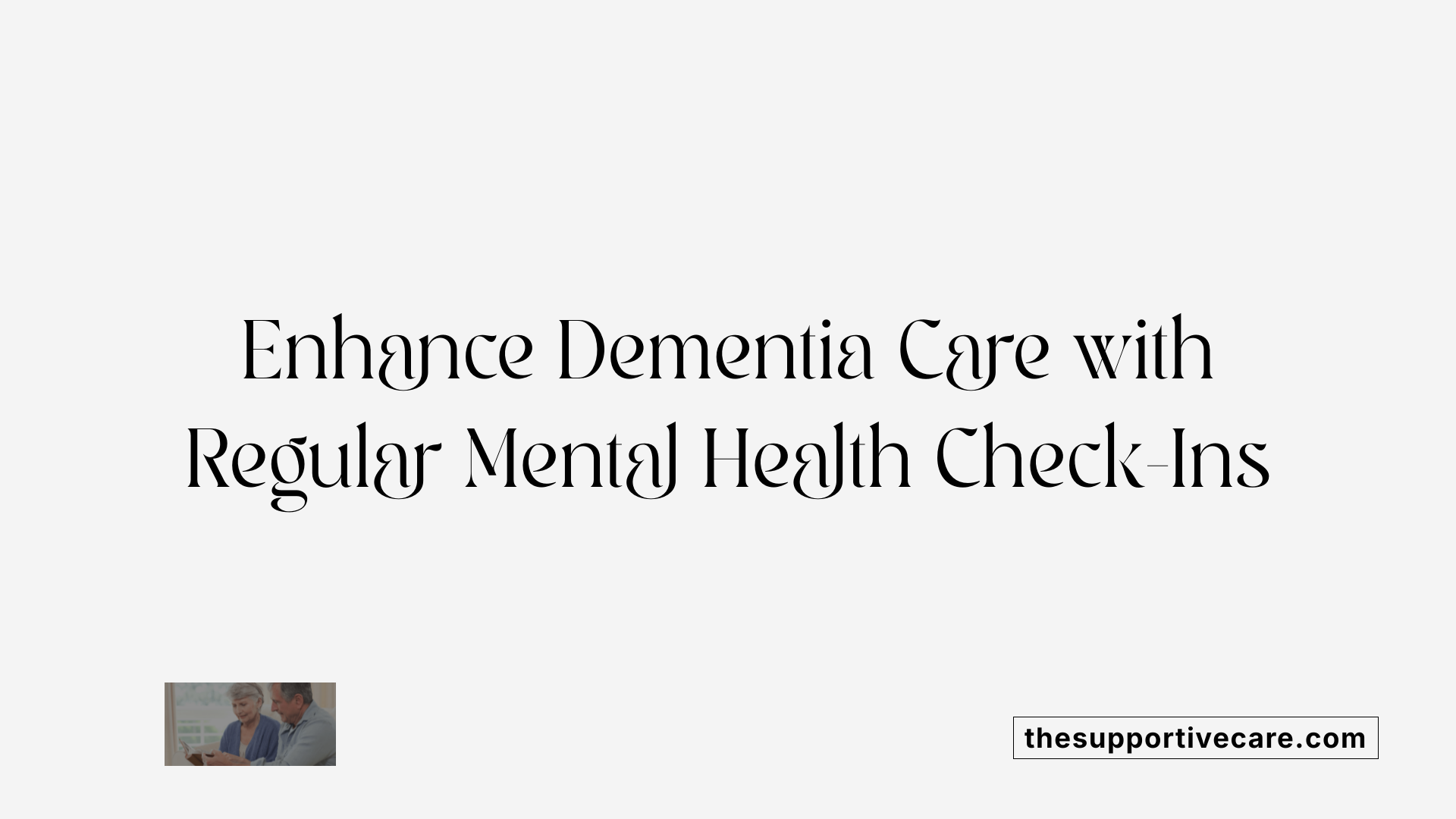
Symptom Management
Older adults with dementia frequently experience behavioral and psychiatric symptoms, including depression, apathy, agitation, and delusions. Since these symptoms affect up to 57.2% of this population, consistent mental health check-ins play a crucial role in managing these challenges effectively. Regular assessments help detect subtle changes in mood and behavior, allowing timely adjustments to treatment plans.
Impact on Care Approaches
Integrating routine mental health check-ins into care settings — especially memory care environments — enhances individualized care for dementia patients. This approach supports caregivers and healthcare providers in recognizing evolving symptoms and tailoring interventions accordingly. Given the complexity introduced by coexisting conditions, regular monitoring ensures comprehensive and responsive care.
Outcome Enhancements
Evidence indicates that consistent mental health check-ins contribute significantly to improved treatment outcomes for older adults with dementia-related depression and apathy. These include increased treatment adherence, reduced symptom relapse rates by up to 25%, and better emotional resilience. Additionally, fostering patient engagement through regular follow-ups encourages a stronger therapeutic alliance, leading to heightened satisfaction and better long-term management of behavioral symptoms.
Embracing Consistent Mental Health Check-Ins to Elevate Senior Care
Regular mental health check-ins are fundamental to addressing the complex and evolving needs of seniors in memory care. By fostering therapeutic alliances, enabling timely treatment adaptations, and integrating comprehensive medical and behavioral services, these check-ins enhance engagement, reduce relapse, and improve overall outcomes. As the senior population grows and diversifies, a well-trained, culturally competent workforce combined with innovative care models and supportive technologies will be essential. Prioritizing consistent mental health monitoring ensures tailored, effective care that supports seniors' dignity, independence, and quality of life.
References
- Assessing the Service Needs of Older Adults with Mental ...
- Psychosocial Interventions for Older Adults With Serious ...
- The Importance of Regular Check-ins in Integrated Treatment
- Addiction Treatment Methods | Evidence-Based Practices
- Treatment | National Institute on Drug Abuse - NIDA
- Substance Use Disorder (SUD): Symptoms & Treatment
- Alcohol & Drug Treatment Center in Gary, Indiana


